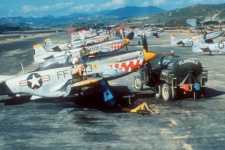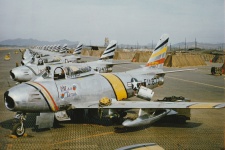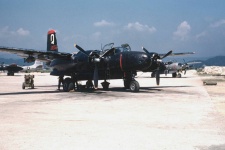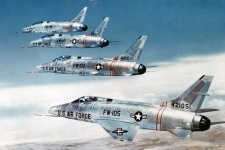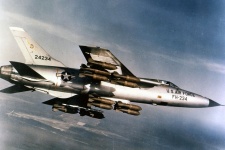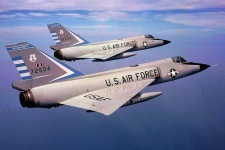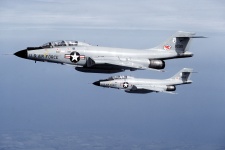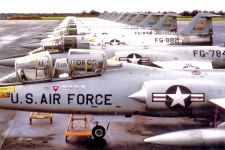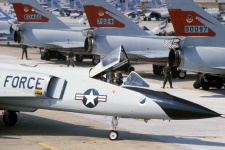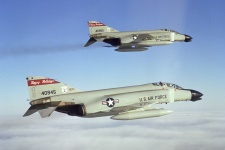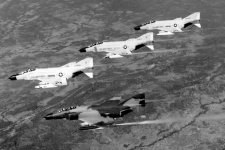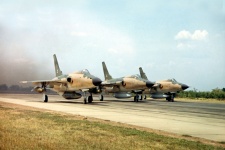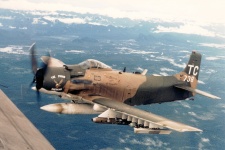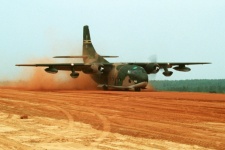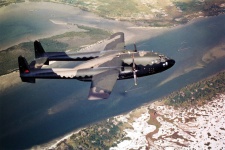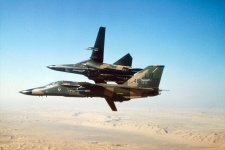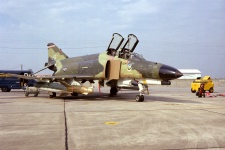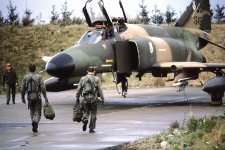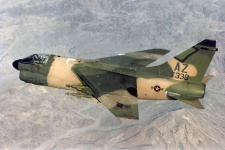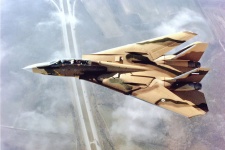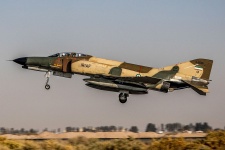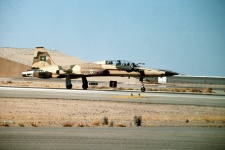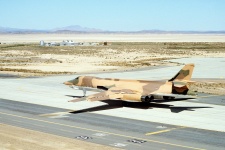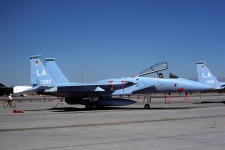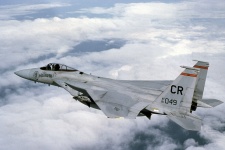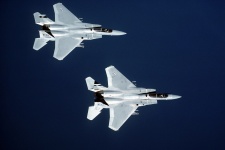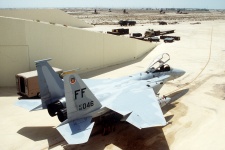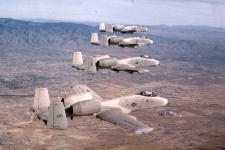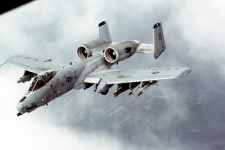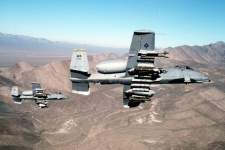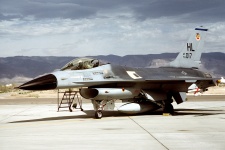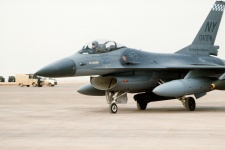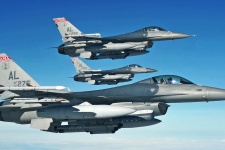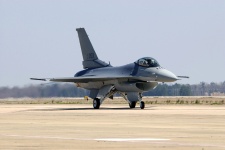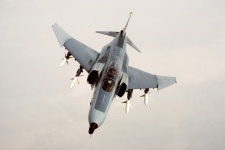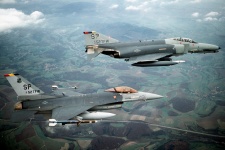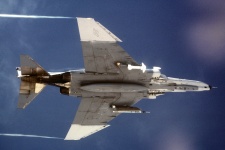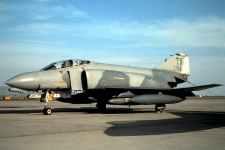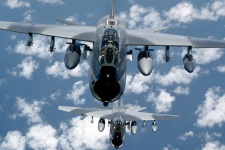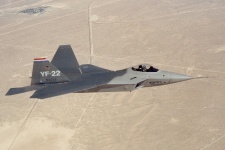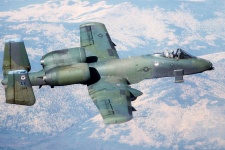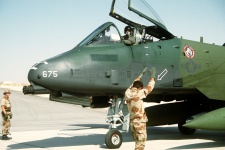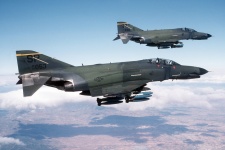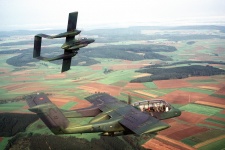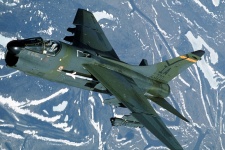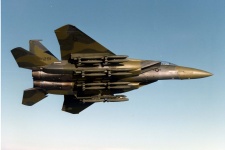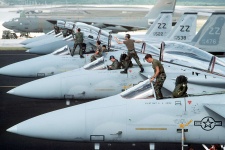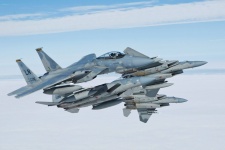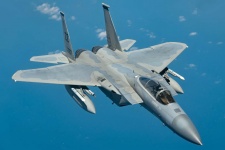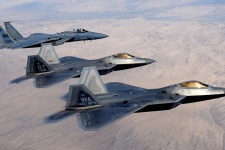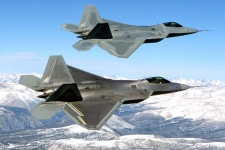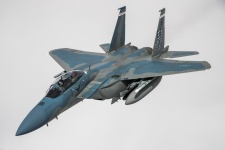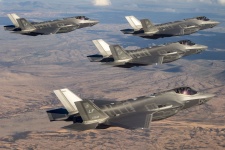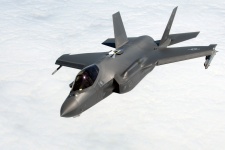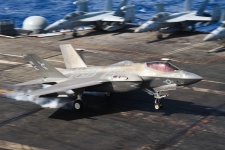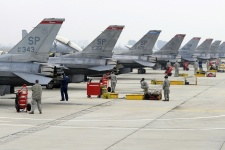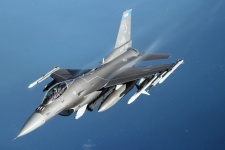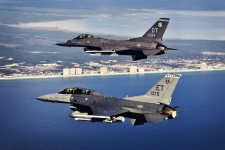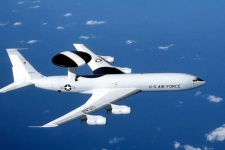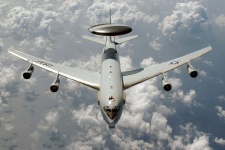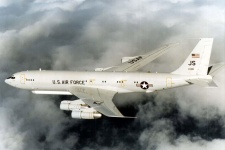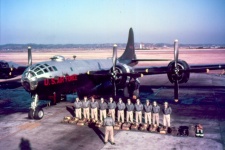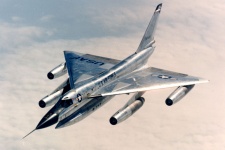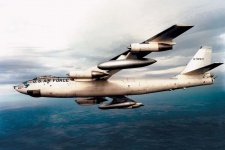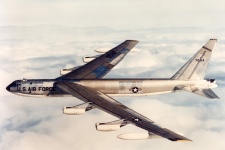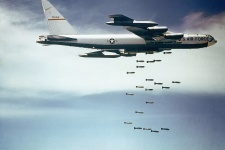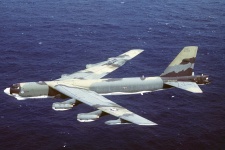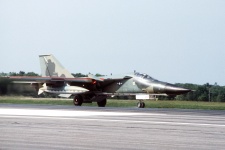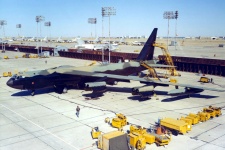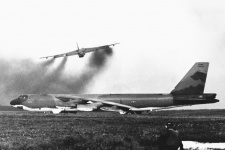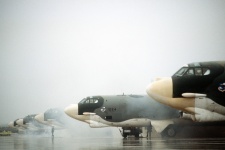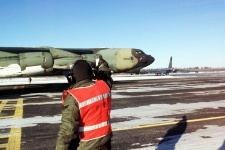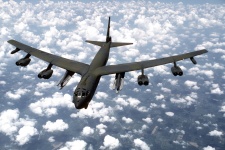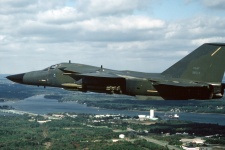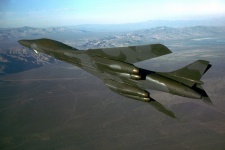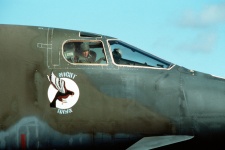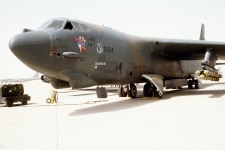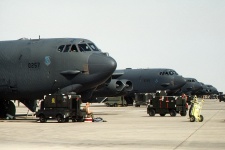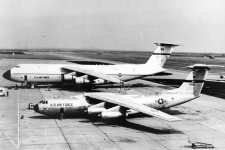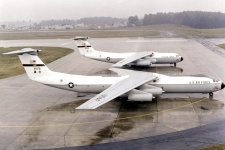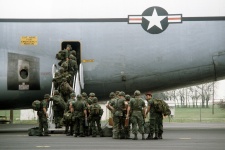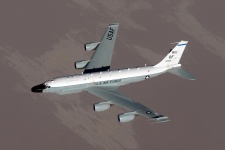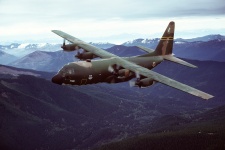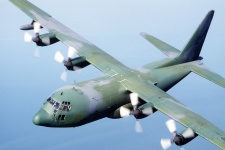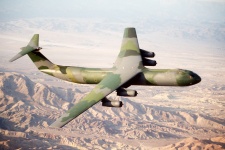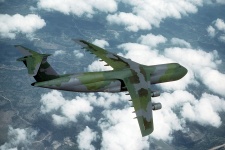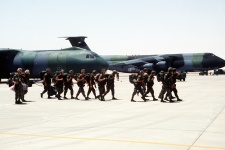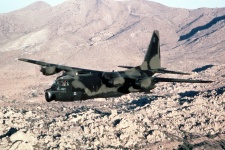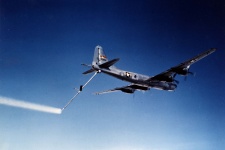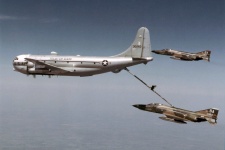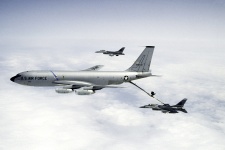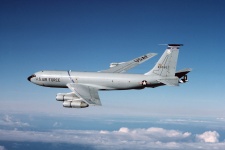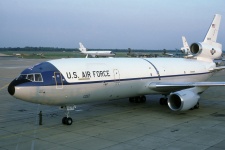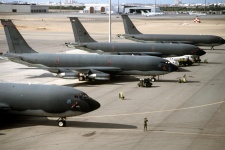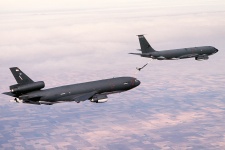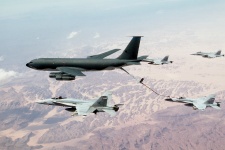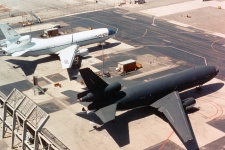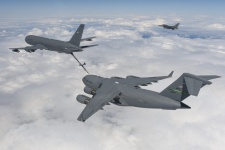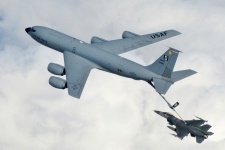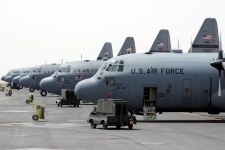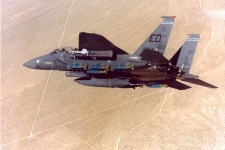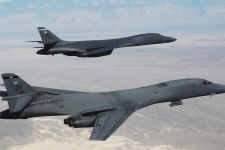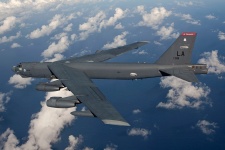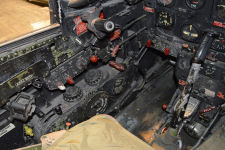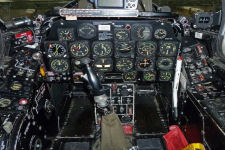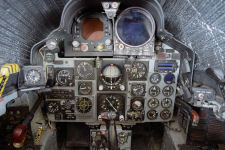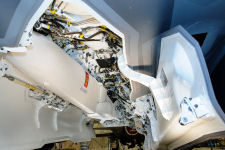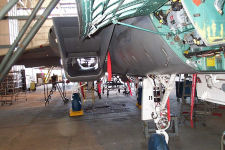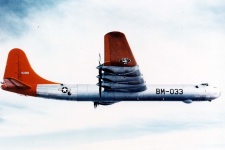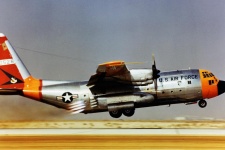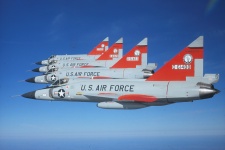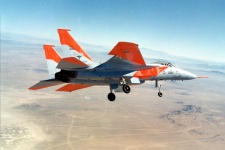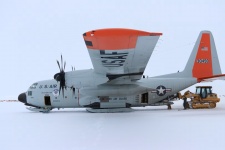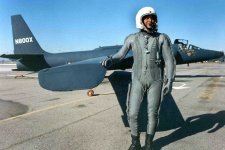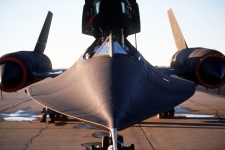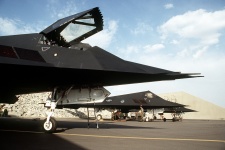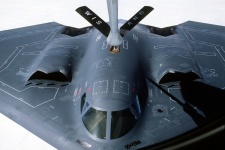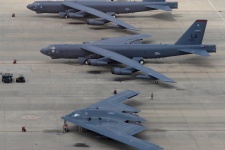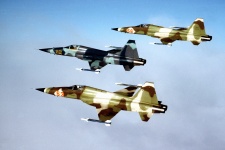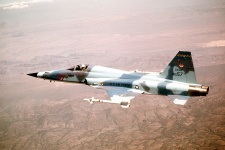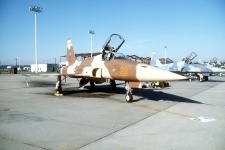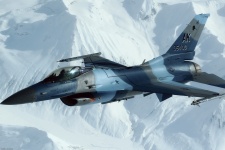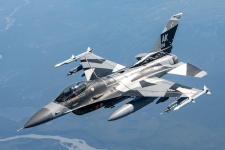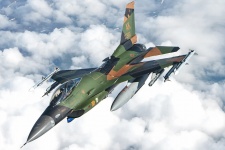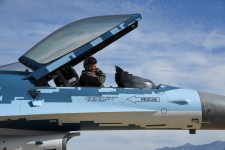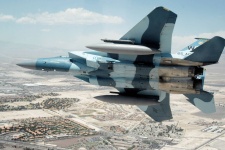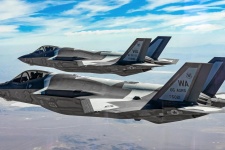Aircraft Colors and Camouflage, US Air Force (1947-Today)
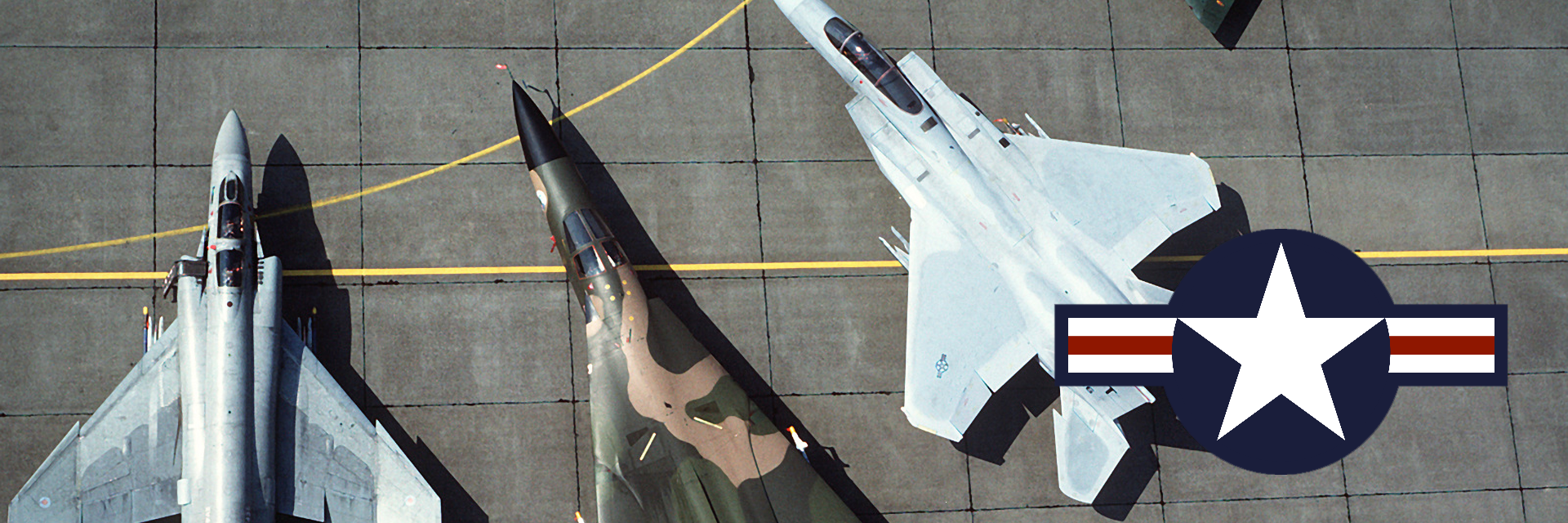
![]()
Introduction to US color standards
The first color standard in use by the US armed forces was known as Specification No. 3-1, introduced on 28 November 1919 and including a palette of 24 colors of which only one would still be in use during World War II. The earliest standard in use by the US Army Air Corps (USAAC) before the war was Specification 14057 which dated from April 1931 and had been revised numerous times since, the latest being Specification 14057-C on 27 December 1939. An updated eight-color, later nine-color, palette was introduced shortly thereafter, in Air Corps Bulletin No. 41 dated 16 September 1940 and this would include all the main colors in use when the US Army Air Force (USAAF) replaced the USAAC in June 1941. Camouflage schemes would later be specified in the Technical Order No. 07-1-1 although in many cases these were applied in an ad hoc manner by commanders in the field. The US Navy (USN) had its own color system during the early years of World War II based around Bureau of Aeronautics (BuAer) Specification M-485 from 6 December 1940 which listed 6, later 7, basic non-spectacular (flat) colors.
The need to unify color codes for the USAAF and USN (which used completely different camouflage schemes) resulted in the Army-Navy Aeronautical (ANA) system, introduced on 28 September 1943. ANA Bulletin No. 157 included an initial palette of 19 mostly flat (plus a few semi-gloss) colors using a three-digit numbering system in the 600s. ANA Bulletin No. 166 added a further 15 gloss colors numbered in the 500s. A number of additional colors were later added for a total of 44. Notably, a few of these were gloss colors but were added to the 600s range regardless. The ANA system also included numerous substitute colors for British colors, necessary in light of the large number of US aircraft provided to the Royal Air Force and Fleet Air Arm through Lend-Lease.
On 12 January 1950, the US published Federal Specification TT-C-595, a new color standard based on a four-digit numbering system used for all federal government procurement. This was short-lived and on 1 March 1956 was superseded by the Federal Standard system, formally known as FED-STD-595. Each color the palette is identified by a five-digit code. The first digit refers to the sheen of the paint, these being gloss (1), semi-gloss (2), and matt (3). The second digit refers to the color, these being brown (1), red (2), yellow (3), green (4), blue (5), gray (6), all others including whites, blacks, and metallics (7), and fluorescents (8). The last three digits are unique for each color and typically go from darker to lighter. The initial palette included 358 colors although not all colors existed in all three sheens. Although the shades are identical regardless of sheen, there have been some well-known exceptions such as Olive Drab whose semi-gloss version used by the US Army on tanks (FS 24087) was different from the matt version used on aircraft and helicopters (FS 34087), this being an error that took decades to correct.
Unlike the ANA system, FED-STD colors do not have official names aside from a small number used for safety, highway, and Army camouflage purposes. Unofficially, names were usually carried over when there was direct ANA predecessor or provided for ease of identification in a technical document, usually in a very generic form (green, brown, tan, etc.). FED-STD-595C included names for colors when used under different standards, in some cases more than one. Many names of FED-STD colors have been popularized by those used by the Testors Model Master paint brand which was the first to cover the majority of US military colors. The color names used on this webiste are therefore not to be considered official and are simply the ones deemed most appropriate by the author to convey them as distinctively as possible.
The Federal Standard system has gone through three major revisions, starting with FED-STD-595A on 2 January 1968 (437 colors), FED-STD-595B on 15 December 1989 (611 colors), and FED-STD-595C on 16 January 2008 (650 colors). Each of these have also been issued Change Notices which represent minor revisions. The ANA Bulletin 157/166 continued to be updated post-war as well and went through five revisions before finally being canceled on 16 April 1970. However, substitute FED-STD-595 colors were first issued in ANA 157d/166d on 11 March 1959, this being the date after which FED-STD-595 became the de facto color standard for military aircraft although occasional references to ANA colors continued for some time. On February 17th, 2017, the Federal Standard system was replaced by the Aerospace Material Specification Standard 595, or AMS-STD-595. It is largely equivalent to the Federal Standard system and all existing colors have been carried over with identical numbers.
USAF camouflage schemes are determined at a major command (MAJCOM) level. The main technical order describing camouflage schemes is T.O. 1-1-4 Exterior Finishes, Insignia and Markings which was first issued 15 July 1959 and last updated (Change 6) on 20 March 1998. However, many schemes are aircraft-specific and described in their individual technical orders rather than T.O. 1-1-4. At this moment, there are significant limits to the online availability of many of these documents which means much of the information below comes from secondary sources, although the greatest of efforts has been made to ensure that these sources are authoritative.
Contents:
- Tactical
- Tactical Air Command (1947-1964)
- Air Defense Command (1956-1980)
- TAC Camouflage / TAC SEA schemes (1964-1996)
- Asia Minor scheme (1971-1982)
- Compass Ghost scheme (1975-Current)
- F-16 / Hill Gray scheme (1978-Current)
- TAC Euro I scheme (1978-1992)
- Mod Eagle scheme (1989-Current)
- F-35 / Have Glass scheme (2016-Current)
- AWACS scheme (1977-Current)
- Strategic
- Strategic Air Command (1947-1964)
- SAC SIOP / SAC SEA schemes (1964-1983)
- SAC Strategic scheme (1983-1992)
- Military Air Transport Service (1948-1966)
- Military Airlift Command (1966-1981)
- MAC Euro I scheme (1981-1992)
- SAC Tanker schemes (1948-1985)
- Shamu scheme (1985-1992)
- Air Combat Command / Air Mobility Command (1992-Current)
- Other
Sources:
- Bell, Dana (1992). USAF Colors and Markings in the 1990s. Greenhill Books, London
External Links:
- FED-STD-595C CHG-1 (31 Jul 2008) @EverySpec
- T.O. 1-1-4 CHG-6 (20 Mar 1998) @EverySpec
- AMS Standard 595A Range Colour Chart @e-paint
How this guide works:
All colors in this page include an equivalences table which is intended to match a color with model paints from 20 different brands including acrylics, lacquers, and enamels. In theory, a model paint should match the exact color specified on its label and also closely resemble that color's official shade, as specified by its national color standard. In practice, many model paints are labeled to match numerous colors and are often inaccurate when comparing them side by side with an official color chip or fan deck. In the equivalences table, you can quickly determine whether a given model paint matches the color in question or has some issue that could compromise its accuracy. The equivalences table is ordered alphabetically but split between traditional (the first ten) and new brands (the last ten). This distinction merely reflects the fact that traditional brands are older and better known, have greater worldwide availability, and are also more frequently referenced in model kit instructions. But it does not imply that they are better or more accurate.
The following nomenclature is used in the equivalences tables. The example uses a hypothetical model paint MP01 labeled to match FS 11136 Insignia Red, a common gloss red used by the US military and specified in the FED-STD-595 color standard.
| Paint | Match or equivalence type (label) |
| MP01 | Labeled to match one specific color (FS 11136) |
| MP01* | Labeled to match one or more colors from a different national standard (FS 11136 / ANA 509) |
| MP01** | Labeled to match one or more colors from a foreign standard (FS 11136 / BS 538) |
| MP01 (!) | Labeled name and color do not match (Insignia Red FS 11350) |
| MP01 (?) | Questionable accuracy of label match (doesn't look like FS 11136) |
| (MP01) | Close equivalent to FS 11136 (BS 538) |
| (MP01) (?) | Questionable equivalent to FS 11136 (Generic Gloss Red) |
| [MP01] | Labeled to match a different sheen of the same color (FS 31136) |
For the most part, matches to different national standards should not be a problem when there is official continuity between them. In the above example, FS 11136 is the official successor to ANA 509 from the earlier Army-Navy Aeronautical standard. Where differences are known to exist, these are mentioned in the text. Matches to foreign standards can be more problematic. Although there are many cases of colors being sufficiently similar as to be good equivalents, in many others it is simply an attempt by the model paint company to avoid the cost of producing an additional color. This may not be an issue to casual modelers, but to those reading this page it puts the accuracy of that paint (and if done repeatedly, the reputation of that brand) in doubt. In this example, FS 11136 and BS 538 (from the British BS 381C color standard) are very close but this is not always the case.
The paint charts make no distinction between gloss, semi-gloss, and matt variants of a color if the specified sheen is unavailable. In the above example, FS 11136 (gloss) is considered identical to FS 31136 (flat). In the few cases where there is a known difference in color between sheens this is indicated in the text and brackets are used to indicate a potential accuracy problem. Non-casual modelers prefer to use clear varnishes to add sheen to a model rather than rely on the sheen of the paint.
Revision 2024 Changes: Unless stated otherwise, text and equivalences tables now refer to the new formulas of Gunze Mr. Hobby Aqueous (2020) and AK Real Colors (2024), while AK 3rd Generation Acrylics (2020) have now replaced the now discontinued original AK acrylic series. Italeri and Tamiya Lacquer have been added. Colourcoats was discontinued in 2024 and has been removed from the tables. Model Master was discontinued in 2020 but will remain listed due to its extensive referencing on many model kits.
Copyright notice: as a result of various copyright violations that have come to my attention, you are reminded that under no circumstance are you permitted to reproduce any or all of the written content on this page without the express permission of the author. Copyright violators will be directly notified and appropriate action will be taken including but not limited to reporting to your IP providers. If you spot this content being reproduced elsewhere, you are kindly requested to report this to me and receive my foremost gratitude for your contribution to fighting rampant internet plagiarism.
![]()
TACTICAL
Tactical Air Command (1947-1964)
The Tactical Air Command was formed on 21 March 1946, a year before the USAF was established, and encompassed fighters, fighter-bombers, ground attackers, and other non-combat aircraft that could be used in support of ground forces or deployed for operations around the world. Daytime operating aircraft continued the late World War II tradition of leaving their aircraft unpainted in their natural metal finish which was primarily aluminum. Different aluminum alloys used throughout the airframe resulted in noticeable contrasts between panels, even more so with gun muzzle panels and engine exhausts which were often made of more heat-resistant material such as stainless steel or titanium and consequently looked darker. An inherent problem with natural metal finishes is their susceptibility to corrosion and as a result, many aircraft (notably the F-100 and F-105) were repainted in aluminum lacquer (FS 17178) beginning in mid-1962 as part of an upgrade program known as Project Look-Alike. This resulted in a more uniform and slightly duller metallic finish, although heat-sensitive panels were still left in natural metal. Night operating aircraft also followed the wartime tradition of being painted in overall ANA 622 Jet (later FS 17038 Black), a highly gloss black that was specifically developed for night operations but which tended to lose much of its glossy sheen in combat conditions.
Aside from the flamboyant unit markings that characterized post-war USAF aircraft, to which was added nose art and other individual adornments during the 1950-53 Korean War, the only part of the aircraft that was typically painted were the anti-glare panels in front of the cockpit. The two most widely used colors for this purpose were ANA 613 Olive Drab (later FS 34087) or ANA 604 Black (later FS 37038), both lusterless (flat). ANA 613 was the final incarnation of olive drab used by the USAAF although its wartime use was limited due to the abandonment of camouflage in 1944. It was slightly lighter and browner than the earlier Dark Olive Drab No. 41 and is believed to be closer to the current FS 34086 than its official FED-STD descendent, FS 34087, which was changed further and later renumbered as FS 34088 (see the USAAF page for the convoluted history of US Olive Drab). Some aircraft, most notably the F-86 and the F-100, did not use anti-glare panels at all while the F-104 used FS 34079 Forest Green and a few F-86Ds were seen with a color resembling FS 34092 Gunship Green. By the time the 1964 edition of T.O 1-1-4 was issued, FS 37038 had been largely standardized as the default color for anti-glare panels and remained so throughout the remainder of the Cold War.
The reign of metal finishes (natural or lacquered) would end in 1964 with the re-introduction of camouflage across all of the USAF's major combat commands including the TAC. A similar shift took place in many other air forces around the world which meant that by the end of the 1960s, it would become rare to see a military aircraft in natural metal.
Paint guide:
- Natural metal: Any aluminum or silver (preferably lacquer) will do for the NMF. Tamiya's LP-11, based on its AS-12 spray can which modelers have long used decanted, is particularly good as it is duller than the typical metallic paint which is more realistic, and also has primer-like durability. Otherwise you are better served by using specific metallic ranges such as Gunze's Super Metallic Silver 2 (SM201) or Vallejo Metal Color Aluminum (77.701), the latter being probably the best metallic paints in acrylic which otherwise tend to be unacceptably grainy. Post-war aircraft generally had many different colored NMF panels so mixing standard aluminum with dark and white aluminum is recommended.
- ANA 613 Olive Drab: There are a decent amount of ANA 613 offerings some of which also match FS 34086 or FS 34088. Generic Gunze, Humbrol, and Tamiya Olive Drabs are added in parenthesis given their widespread availability. ANA 613 is believed to be a close match to RAL 7013 which would also allow for Revell 46 (oddly labeled as Nato-Oliv) as an alternative. Tamiya XF-62/LP-28 are noticeably green and certainly do not capture the browner tone of ANA 613 although they are included in the table regardless. Given that post-war use of ANA 613 was relegated to anti-glare panels, any US Olive Drab should be suitable.
- ANA 622 Jet: This color is essentially a gloss black although it frequently took a duller appearance in combat, so any black regardless of sheen is good. A lighter black grey such as NATO Black FS 37030 is preferable to allow for tonal variation which it comes to large areas like the full undersides or fuselage. Gloss black matches are provided below.
| FS 17178 | FS 34087 | FS 37038 | FS 17038 | |
| ANA 613 | ANA 604 | ANA 622 | ||
| Aluminum | Olive Drab | Black | Jet | |
| Schemes | ||||
| TAC Day | Overall | (Anti-glare) | (Anti-glare) | |
| TAC Night | Overall | |||
| Color matches | ||||
| Gunze Mr. Color | C8 | (C12) | C33 | C2 |
| Gunze Mr. Hobby | H8 | (H52) | H12 | H2 |
| Humbrol | 56 | (155) | 33 | 21 |
| Italeri | 4678AP | 4842AP | 4768AP | 4695AP |
| Model Master | 1781 | 2050 | 1749 | 1747 |
| Revell | 99 | - | 08 | 07 |
| Tamiya Acrylic | XF-16 | (XF-62) | XF-1 | X-1 |
| Tamiya Lacquer | LP-11 | (LP-28) | LP-3 | LP-1 |
| Vallejo Model Air | 71.062 | 71.016* | 71.057 | - |
| Vallejo Model Color | - | 70.887* | 70.950 | 70.861 |
| AKAN | 6/76004 | 6/72033 | 78003 | - |
| AK 3Gen Acrylic | AK11287 | AK11863 | AK11029 | - |
| AK Real Colors | RC8200 | - | RC804 | - |
| AMMO by Mig | A.MIG-194 | A.MIG-240* | A.MIG-046 | - |
| Hataka | HTK-_078 | HTK-_018 | HTK-_041 | HTK-_100 |
| Lifecolor | LC 74 | - | LC 02 | LC 52 |
| Mission Models | MMM-003 | - | MMP-047 | - |
| Mr. Paint | MRP-3 | MRP-138 | MRP-5 | MRP-172 |
| Xtracolor | X142 | X112 | X404 | X012 |
| Xtracrylix | XA1216 | XA1112 | - | XA1012 |
Air Defense Command (1956-1980)
The Air Defense Command (ADC), later Aerospace Defense Command (ADCOM) from 1968 onward, was a special command of the USAF tasked with defending the continental air space of the US, and existed between 1946 and 1980 in some guise or another. It included all purpose-built Cold War-era interceptors such as the F-94, F-101, F-102 and F-106 as well as tactical fighters like the F-4 when assigned to fighter-interceptor squadrons including those in the ANG. ADC/ADCOM aircraft featured a single-color scheme consisting of FS 16473 Aircraft Gray (previously ANA 512), a light gray with a subtle sea green tone. This color is so closely associated with the ADC that it is often referred to as ADC Gray. It is not clear to this author which year the conversion to this scheme took place. On one hand, it appears that all production F-102 and F-106 interceptors were delivered in FS 16473 after their introduction to USAF service in 1956 and 1959 respectively. The F-102 was possibly delivered in ANA 512 (only slightly bluer than FS 16473) since FED-STD colors did not officially begin to be used on military aircraft until 1959. On the other hand, F-101s and F-104s in ADC service were seen in natural metal until the early 1960s when they began appearing in FS 16473. This was also the case with the EC-121 airborne early warning and control aircraft which was used by the ADC/ADCOM for offshore radar surveillance.
By this time, interceptors were all-weather and were equipped with radar. Radome colors could vary but were eventually standardized into gloss FS 17038 Black (previously ANA 515). Anti-glare panels, which were located in front of the canopy were painted FS 37038 Black (previously ANA 604). Sometimes the anti-glare panel would curve down around the radome for aesthetic purposes but only the section in front of the cockpit was flat FS 37038, the rest was gloss FS 17038 like the radome. The ADC scheme continued the use of large 'U.S. Air Force/Air National Guard' and 'USAF/ANG' letting on the fuselage and wings but this was now painted FS 15044 Insignia Blue (previously ANA 502). Additionally, fighter-interceptor squadron markings tended to be large and colorful which made ADC/ADCOM aircraft much more pleasing to the eye than the simplicity of the scheme would suggest.
The ADC scheme would subsequently become the standard one for all tactical-sized aircraft that did not have other camouflage schemes specified. A notable exception were the first batches of F-4Cs which were delivered to the USAF in 1963 in the contemporary US Navy scheme of FS 16440 over FS 17875. These included the initial F-4Cs deployed to Thailand in 1965 for operations over Vietnam. ADCOM ceased to operate interceptor units in October 1979 and was disbanded on 31 March 1980, at which point air defense duties passed on to Air Defense, Tactical Air Command (ADTAC). At this time, only the F-101 (retired in 1982), F-106, and F-4 were left from the ADCOM inventory and new aircraft types that were employed by ADTAC (namely the F-15) retained their existing camouflage schemes rather than FS 16473. ADTAC was disbanded on 6 December 1985 and the Air National Guard (ANG) has taken up air defense duties ever since.
Paint guide:
- FS 16473 Aircraft Gray: This did not get much love from the traditional paint brands aside from Gunze's C73/H57 which oddly does not label it with an FS number and describes it as a USN color which it is not. But it is a very good match regardless. Thankfully the newer brands have this color covered it far more extensively. Tamiya XF-19 is often said to be an equivalent but it is too neutral, lacking the tinge of sea green that this color is known for.
| FS 16473 | FS 17038 | |
| Aircraft Gray | Black | |
| Schemes | ||
| Basic | Overall | Radome |
| Color matches | ||
| Gunze Mr. Color | C73 | C2 |
| Gunze Mr. Hobby | H57 | H2 |
| Humbrol | - | 21 |
| Italeri | - | 4695AP |
| Model Master | 1731 | 1747 |
| Revell | - | 07 |
| Tamiya Acrylic | - | X-1 |
| Tamiya Lacquer | - | LP-1 |
| Vallejo Model Air | 71.335** | - |
| Vallejo Model Color | - | 70.861 |
| AKAN | 6/72027 | - |
| AK 3Gen Acrylic | AK11867 | - |
| AK Real Colors | RC890 | - |
| AMMO by Mig | - | - |
| Hataka | HTK-_045 | HTK-_100 |
| Lifecolor | UA 041 | LC 52 |
| Mission Models | MMP-102 | - |
| Mr. Paint | MRP-242 | MRP-172 |
| Xtracolor | X138 | X012 |
| Xtracrylix | XA1138 | XA1012 |
TAC Camouflage / TAC SEA schemes (1964-1996)
As the US's participation in the Vietnam War escalated, the need to create new camouflage schemes appropriate for the combat conditions in South-East Asia became apparent. In 1964, Tactical Air Command introduced its very first disruptive camouflage scheme which began to be seen in the skies over Vietnam from 1965 onward. This has led to its erroneous labeling as the South-East Asia (SEA) scheme when in fact, it was applied to virtually all TAC aircraft regardless of whether they were deployed in that theater or not. The new TAC camouflage scheme was based on a disruptive pattern consisting of two low contrast greens and a brown. The greens consisted of FS 34079 Forest Green, a dark green that was also widely used by the US Army, along with FS 34102 Medium Green, a dark olive green when freshly painted but which often took a lighter and deeper tone. The brown was FS 30219 Dark Tan which had a tendency to fade towards a lighter, desert yellow. Undersides were painted in FS 36622 Camouflage Gray, a slightly warm light gray that in many photographs appears more like an off white. The disruptive pattern was specific for each aircraft as determined in T.O. 1-1-4, although its freehand application resulted in noticeable variations across each individual airframe.
As already mentioned, the new TAC camouflage scheme's association with the Vietnam War has led to it being invariably referred to as the SEA scheme ever since. Nevertheless, an actual SEA scheme existed which had the FS 36622 undersides replaced with FS 17038 Black. This was applied in the South-East Asia theater to aircraft used for night operations, gunships (AC-47, AC-119), F-4Ds from the 479th Tactical Fighter Squadron, and the F-111 (not including the strategic FB-111 variant). In the particular case of the F-111, the SEA scheme was used almost exclusively until its retirement from active USAF service in 1996. There are also numerous photographs that show Europe-based F-4s with an unidentified light green color instead of FS 30219. This was initially believed to be a new scheme adapted for temperate environments but is now known to have been the result of bad FS 30219 paint batches, although the question remains why these were allowed in an air force generally known for its strict adherence to standards. Around 1979, it was decided to convert the TAC scheme into a full wraparound, omitting the FS 36622 undersides. This change coincided with a switch to less conspicuous black (FS 37038) markings and insignia. Although this variant was relatively short-lived, the wraparound camouflage and all-black markings were carried over to the Euro I scheme that followed.
The TAC camouflage scheme (or localized variations of it) was adopted many air forces worldwide given its suitability for many different environments. It was particularly popular in Latin America and Asia but also taken up by a number of NATO countries that adopted the F-4. Even in temperate regions like Central Europe, it was a considerable improvement over natural metal finishes which had hitherto been the standard on TAC aircraft. Overall, the TAC camouflage scheme stands as one of the most iconic of the mid-Cold War period and especially of the Vietnam War, so much that it probably deserves its mislabel as the SEA scheme after all.
Paint guide:
- FS 34102 Medium Green: This is a complicated color to interpret. On one hand, the color chips show relatively modest contrast with the darker FS 34079. However, many photos show much greater contrast and also a deeper tone to the olive green seen in the color chips. Gunze H303/C303 is closer in tone to the chip but noticeably lighter, whereas the AK Real Colors and MRP version is deeper and closer to the photos.
- FS 34079 Forest Green: This is one of the few military colors that tends to be almost universally accurate so it's hard to go wrong. The Italeri version (4726AP) is labeled as RAF Dark Green, which is often matched to FS 34079 although it is noticeably browner.
Links:
| FS 30219 | FS 34102 | FS 34079 | FS 36622 | FS 17038 | |
| Dark Tan | Medium Green | Forest Green | Camouflage Gray | Black | |
| Schemes | |||||
| TAC | Upper Camo | Upper Camo | Upper Camo | Lower | |
| TAC SEA | Upper Camo | Upper Camo | Upper Camo | Lower | |
| TAC Wraparound | Wrap Camo | Wrap Camo | Wrap Camo | ||
| Color matches | |||||
| Gunze Mr. Color | C310 | C303 | C309 | C311 | C2 |
| Gunze Mr. Hobby | H310 | H303 | H309 | H311 | H2 |
| Humbrol | 118 | 117 | 116 | 28 | 21 |
| Italeri | 4709AP | 4862AP | 4726AP (!) | 4763AP (!) | 4695AP |
| Model Master | 1742 | 1713 | 1710 | 1733 | 1747 |
| Revell | - | - | - | - | 07 |
| Tamiya Acrylic | - | - | - | - | X-1 |
| Tamiya Lacquer | - | - | - | - | LP-1 |
| Vallejo Model Air | 71.125 | 71.289 | 71.294 | 71.296 | - |
| Vallejo Model Color | 70.874* | - | 70.893 | - | 70.861 |
| AKAN | 6/72021 | 6/72003 | 6/72002 | 6/72023 | - |
| AK 3Gen Acrylic | AK11121 | AK11342 | AK11346 | AK11890 | - |
| AK Real Color | RC895 | RC905 | RC900 | RC922 | - |
| AMMO by Mig | A.MIG-202 | A.MIG-004 | A.MIG-206* | A.MIG-226 | - |
| Hataka | HTK-_012 | HTK-_021 | HTK-_016 | HTK-_039 | HTK-_100 |
| Lifecolor | UA 015 | UA 002 | UA 001 | UA 021 | LC 52 |
| Mission Models | MMP-066 | MMP-028** | MMP-058 | MMP-095 | - |
| Mr. Paint | MRP-103 | MRP-102 | MRP-101 | MRP-104 | MRP-172 |
| Xtracolor | X102 | X116 | X110 | X140 | X012 |
| Xtracrylix | XA1102 | XA1116 | XA1110 | XA1140 | XA1012 |
Asia Minor scheme (1971-1982)
Although the TAC camouflage scheme was considered effective for most regions that the USAF would be expected to operate from, it was clearly not ideal for arid or desert environments such as the Middle East. As a result, a new camouflage was developed which was better optimized for this purpose, the name Asia Minor referring to the likelihood that USAF aircraft would be deployed to Turkey if conflict in the region were to break out. The new scheme had a similar pattern to the previous one, but featured two topside tans and just one green. The lighter tan was FS 20400 Tan Special, a desert yellow that gets considerably yellower over time. The use of semi-gloss paint appears puzzling but it is simply because this color does not exist in the FED-STD palette in any other sheen (what is truly puzzling is that it hasn't been added since). The darker tan was FS 30140 Brown Special, a medium brown which has a tinge of red that tends to get lost through fading. Two colors from the previous TAC scheme were reused for Asia Minor, this being FS 34079 Forest Green as the third topside color and FS 36622 Camouflage Gray for the underside. Notably, FS 20400 predominates on the upper wing surfaces of larger airframes like the F-4 and F-14, in the latter case, FS 30140 and FS 34079 act more like secondary contrast colors as seen on other camouflage schemes like MERDC (US Army).
In the event, the Asia Minor scheme was not used operationally by the USAF even though diagrams for numerous aircraft (C-47, C-54, C-130, F-5, F-84, F-101, and F-104) were included in T.O. 1-1-4. It is best known for being the scheme applied to F-4s and F-14s exported to the pre-revolution Imperial Iranian Air Force (IIAI) as well as C-130s and F-5s exported to various Middle Eastern countries (Iran, Jordan, and Saudi Arabia). The scheme remained in use with the post-revolution Islamic Republic of Iran Air Force (IRIAF) until a switch to localized camouflage in the 1990s. Despite its lack of USAF use, the two special tans of the Asia Minor scheme (FS 20400 and FS 30140) would be subsequently seen on helicopter camouflage and aggressor schemes.
Paint guide:
- FS 20400: Moderately well represented among the newer brands. Mr Paint (MRP-244) looks too light and pale but Vallejo Model Air (71.348) looks a bit better. This color was in the original AK Real Colors catalog but sadly discontinued in the 2024 reformulation. Note that AK11116 is offered as an equivalent in an AK 3Gen Acrylic Asia Minor set but this is matched by AK themselves to FS 33245 which would be too yellowish.
- FS 30140: Moderately well represented among the newer brands. Mr Paint (MRP-233) appears too red in the bottle and Vallejo Model Air (71.035) too brown. This color was in the original AK Real Colors catalog but sadly discontinued in the 2024 reformulation although it is avialble in the 3Gen Acrylic range (11120). RAL 8025 is considered a close approximation which would make Revell 381 suitable.
- FS 34079: described previously.
- FS 36622: described previously.
Sources:
| FS 20400 | FS 30140 | FS 34079 | FS 36622 | |
| Tan Special | Brown Special | Forest Green | Camouflage Gray | |
| Schemes | ||||
| Asia Minor | Upper Camo | Upper Camo | Upper Camo | Lower |
| Color matches | ||||
| Gunze Mr. Color | - | - | C309 | C311 |
| Gunze Mr. Hobby | - | - | H309 | H311 |
| Humbrol | - | - | 116 | 28 |
| Italeri | - | 4846AP (!) | 4726AP (!) | 4763AP (!) |
| Model Master | 2021 | 1754 | 1710 | 1733 |
| Revell | - | - | - | - |
| Tamiya Acrylic | - | - | - | - |
| Tamiya Lacquer | - | - | - | - |
| Vallejo Model Air | 71.348 | 71.035 | 71.294 | 71.296 |
| Vallejo Model Color | 70.893 | - | ||
| AKAN | 6/72011 | 72010 | 6/72002 | 6/72023 |
| AK 3Gen Acrylic | - | AK11120 | AK11346 | AK11890 |
| AK Real Color | - | - | RC900 | RC922 |
| AMMO by Mig | - | - | A.MIG-206* | A.MIG-226 |
| Hataka | HTK-_187 | HTK-_160 | HTK-_016 | HTK-_039 |
| Lifecolor | UA 084 | UA 085 | UA 001 | UA 021 |
| Mission Models | - | - | MMP-058 | MMP-095 |
| Mr. Paint | MRP-244 | MRP-233 | MRP-101 | MRP-104 |
| Xtracolor | X145 | - | X110 | X140 |
| Xtracrylix | - | - | XA1110 | XA1140 |
Compass Ghost scheme (1975-Current)
The Vietnam War demonstrated the need to make tactical aircraft, particularly fighters, less observable than what existing TAC schemes could afford. As early as World War II, an experiment known as Project Yehudi added spotlights to the cowling and leading edges of aircraft in order to compensate for the fact that aircraft would appear dark against a bright sky. A similar experiment known as Project Compass Ghost was undertaken during the Vietnam War, which involved fitting lamps on the undersides of an F-4 Phantom whose large size made it particularly visible, especially compared to the smaller Vietnamese MiGs. Although the project itself was never implemented operationally, it would lead to the introduction of lighter camouflage on the USAF's then-newest combat aircraft, the F-15. When first delivered in 1974, the F-15As featured a monotone scheme consisting of FS 35450 Air Superiority Blue, with only the undersides of the nose, the wings, and the horizontal stabilizers painted in its gloss FS 15450. However, this color was seen as impractical in the more overcast skies of Europe which resulted in the introduction of a low-contrast two-tone gray scheme, referred to unofficially as the Compass Ghost or Ghost Grey scheme and officially (as per the 21 March 1978 version of TO-1-1-4) as simply High and Low Reflectance Gray. The colors consisted of FS 36375 Light Ghost Gray, a slightly blue-tinted light gray, as the base color with the only moderately darker FS 36320 Dark Ghost Gray in a wave pattern that avoided the edges of the aircraft (except on the inner vertical stabilizers where the colors were reversed). Although the Compass Ghost scheme was introduced as early as 1975, the year after the F-15 was first delivered, these two colors were only officially added to the FED-STD-595A palette on 1 March 1979 (Change Notice 5). Interestingly, the Air Superiority Blue scheme remained an official F-15 scheme into the 1990s even though it was only used briefly, mostly by the 555th 'Triple Nickel' TFTS which was the first unit (a training squadron at the time) to receive the F-15 in 1974.
The Compass Ghost scheme would kick off a trend of using light/medium greys in much simpler camouflage schemes that by the 1990s became almost universal not just among US forces (including the USN and USMC) but also among most NATO air forces too. A slightly simpler version of this scheme, with a curved demarcation across the fuselage sides and engines, is currently used on A-10s and first appeared around 1994 (it was already included in the 14 May 1994 version of TO-1-1-4). It also includes a false canopy on the underside nose painted FS 36118 Medium Gunship Gray. This pattern was similar to the original camouflage scheme of the A-10 which was based on a special paint known as MASK-10A which had radar and infrared reflective properties. The darker topside paint was stated at 30% reflectance, and the lighter underside paint at 50% reflectance. Though neither was matched to a FED-STD color, they appear closest to FS 36320 and FS 36628 Light Arctic Gray respectively. MASK-10A was applied to all new A-10s until January 1979 when they switched to Euro I.
The Compass Ghost scheme was also adopted by foreign users of the fighter versions of the F-15, namely Israel and Japan, the latter which also eventually applied it to its F-4EJ Phantoms. The basic pattern would be carried over in identical fashion to the Mod Eagle scheme which was gradually adopted by USAF F-15s in the 1990s.
Paint Guide:
- FS 35450 Air Superiority Blue: Many of the newer paint manufacturers carry this color, as does Gunze in its Mr. Color range. Note that the undersides of the nose, the wings, and the horizontal stabilizers were in gloss (FS 15450) although in practice the difference was probably not very noticeable.
- FS 36375 Light Ghost Gray: Being possibly the most common USAF/USN color, it is important to get this color right and also ensure that it harmonizes well with its counterpart, FS 36320 given that both are typically used together. Sadly discontinued, Model Master was for a long time the gold standard for both Ghost Grays but some of the newer ranges have very good representations including AK Real Colors and Lifecolor which capture the slightly bluish tint perfectly. Both Gunze (C308/H308) as well as Tamiya (only available in LP-37 lacquer) versions harmonize well with each other but are noticeably bluer than they should be, with Tamiya perhaps excessively so. Note that the old formula Gunze H308 had an annoying purplish tint which contrasted with the far more accurate H307 (FS 36320). In contrast, the MRP version appears too grey. Strangely Vallejo only includes this rather vital color as a primer (70.615) rather than in its more airbrush-friendly Model Air range and is also a bit too pale looking though still acceptable.
- FS 36320 Dark Ghost Gray: As with its lighter counterpart, Model Master, AK Real Colors, and Lifecolor are possibly the best, with Gunze and Tamiya also too blue and MRP also too gray. This color is available in the Vallejo Model Air range and is a decent match as well.
Sources:
- Bell, Dana (1989). 'A-10A Mask-10A Schemes', FineScale Modeler, 7(2), p. 56.
Links:
- Aerial Camouflage – Why It’s Not Easy Being Green…with White Patches and Red Crosses
- Stealth Aircraft: The Old Becomes New Again
- Light Ghost gray spraying issue? (ARC Discussion Forums)
| FS 35450 | FS 36375 | FS 36320 | |
| Air Superiority Blue | Light Ghost Gray | Dark Ghost Gray | |
| Scheme | |||
| Air Superiority (F-15) | Overall | ||
| Compass Ghost (F-15) | Base | Upper Camo | |
| Compass Ghost (A-10) | Lower | Upper | |
| Color matches | |||
| Gunze Mr. Color | C74 | C308 | C307 |
| Gunze Mr. Hobby | - | H308 | H307 |
| Humbrol | - | 127 | 128 |
| Italeri | - | 4762AP (!) | 4761AP (!) |
| Model Master | - | 1728 | 1741 |
| Revell | - | - | - |
| Tamiya Acrylic | - | - | - |
| Tamiya Lacquer | - | LP-37 | LP-36 |
| Vallejo Model Air | 71.332* | - | 71.120 |
| Vallejo Model Color | - | 70.615 | - |
| AKAN | - | 6/72032 | 6/72030 |
| AK 3Gen Acrylic | AK11879 | AK11888 | AK11887 |
| AK Real Color | RC910 | RC920 | RC919 |
| AMMO by Mig | - | A.MIG-203 | A.MIG-208 |
| Hataka | HTK-_155 | HTK-_037 | HTK-_035 |
| Lifecolor | UA 037 | UA 026 | UA 027 |
| Mission Models | - | MMP-073 | MMP-074 |
| Mr. Paint | MRP-240 | MRP-38 | MRP-97 |
| Xtracolor | - | X136 | X135 |
| Xtracrylix | - | XA1136 | XA1135 |
F-16 / Hill Gray schemes (1978-Current)
A three-color gray camouflage was developed specifically for the new F-16 Fighting Falcon (or Viper as it is better known) lightweight fighter, which entered service with the USAF in 1978. It was initially (and unofficially) known as the Egypt I scheme, most likely because F-16s participated soon after their introduction in the annual Bright Star exercises in that country. This consisted of two high-contrast topside grays which were FS 36118 Medium Gunship Gray for the upper wings and upper fuselage up to the canopy area (the actual position varied but could be as far forward as mid-canopy), and FS 36270 Medium Gray for the upper forward fuselage, stabilizers, fin, and wing pylons. The lower fuselage color, which included all areas under the chord line, was FS 36375 Light Ghost Gray with the exception of the upper part of the intake which was left in FS 36270 since it could be visible from above. FS 36118, which going forward would be one of the most widely used USAF camouflage colors, is the direct successor to the wartime ANA 603 Sea Gray and is a darker gray with a noticeable blueish tone. FS 36270 is best known in naval circles as Haze Gray, the main color of US Navy ships since World War II. Its actual tone can be confusing given that many photos show it as being bluer than it actually is, but in reality is closer to a neutral gray and visibly warmer than either of the ghost grays.
A similar Project Hill Variable Gray Paint Scheme (usually shortened to just Hill Gray) was subsequently applied to existing USAF F-4E/Gs. The name of the scheme referenced Hill AFB which was the primary maintenance center for USAF F-4s. The original version of this scheme, later known as Hill Gray I, used the same three-color combination as the F-16 and was approved in November 1985. The pattern was similar to that on the F-16, though notably the FS 36118 did not extend to the outer dihedral section of the wings. Pilots soon found that the undersides reflected too much light during rolls and as a result, it was suggested to mirror the topside pattern on the undersides which had the additional benefit of confusing enemies as to the orientation of the aircraft. The darker grey was also to be extended forward of the canopy as an anti-glare panel. The resulting scheme was known as Hill Gray II and units began transitioning in 1986 with a further change being the adoption of semi-gloss paints, FS 26270 and FS 26118. After the 1991 Gulf War, USAF F-16s adopted similar coloring to Hill Gray II by replacing the FS 36375 undersides with FS 36270 but without the mirrored topside pattern. This change, which was also accompanied by a switch to low-visibility (low-vis) markings, was done at the depot level given that all USAF F-16s were delivered from the factory with FS 36375 undersides. Another aircraft that used the Hill Gray II colors, though not the pattern, was the A-7D which adopted a disruptive wraparound on some ANG units.
The color of F-16 radomes has been subject to much speculation given the wide variety of tones which have been observed. The F-16 was originally introduced with black radomes but this was quickly abandoned after pilots complained that this made their aircraft stick out during dogfights. As a result, FS 36270 has been adopted as the standard radome color to this day. The somewhat extreme color variations seen in service is largely due to radomes being built of dielectric material with a neoprene coating which fades differently from the rest of the fuselage. Additionally, the neoprene coating tends to get dirty much easier than the aluminum fuselage, which explains the usual darkening of radomes over time. Unlike the F-16, F-4s using the Hill Gray II scheme typically had only the tip of their radomes in black. For modeling purposes, it is recommended to darken FS 36270 or use another darker gray (preferably a warmer gray like FS 36251) to properly represent the color of F-16 radomes.
Paint guide:
- Light Ghost Gray FS 36375: Described previously.
- Medium Gray FS 36270: Widely available in most paint ranges. Gunze H306/C306, like their ghost grays, errs slightly on the bluer side but is good overall as is Vallejo Model Air (71.275). The AK Real Color version (RC279) is too warm and looks more like stone grey. There is no direct Tamiya acrylic equivalent but a slightly lightened XF-83 (Medium Sea Grey) could be a close approximation. There is no lacquer version either although it does exist as a spray (AS-7) which can be decanted.
- Medium Gunship Gray FS 36118: Almost universally available and, better yet, almost universally accurate which is sadly a rarity among modeling paints. The old formula Gunze H305 was a rare miss, being too light and lacking the bluish tone although some consolation was that it made a very good color for the radomes. The new formula version is much more accurate. Despite its generic name, Tamiya XF-24 Dark Grey is a near perfect match.
Sources:
- Bell, Dana (1992). 'Project Hill F-4 Phantom II', FineScale Modeler, 10(1), p. 109.
- Bell, Dana (1994). 'U.S. Air Force A-10A Ghost Scheme', FineScale Modeler, 12(5), p. 40.
| FS 36118 | FS 36270 | FS 36375 | |
| Medium Gunship Gray | Medium Gray | Light Ghost Gray | |
| Schemes | |||
| F-16 / Hill Gray I | Upper | Sides | Lower |
| Hill Gray II | Upper | Lower | |
| Color matches | |||
| Gunze Mr. Color | C305 | C306 | C308 |
| Gunze Mr. Hobby | H305 | H306 | H308 |
| Humbrol | 125 | 126 | 127 |
| Italeri | 4752AP | 4746AP | 4762AP (!) |
| Model Master | 1723 | 1725 | 1728 |
| Revell | 74 | 43 | - |
| Tamiya Acrylic | (XF-24) | - | - |
| Tamiya Lacquer | - | LP-85 | LP-37 |
| Vallejo Model Air | 71.097* | 71.275 | - |
| Vallejo Model Color | 70.836* | 70.870 | 70.615 |
| AKAN | 6/72040 | 6/72028 | 6/72032 |
| AK 3Gen Acrylic | AK11881 | AK11886 | AK11888 |
| AK Real Colors | RC913 | RC918 | RC920 |
| AMMO by Mig | A.MIG-204 | A.MIG-211 | A.MIG-203 |
| Hataka | HTK-_031 | HTK-_054 | HTK-_037 |
| Lifecolor | UA 022 | UA 028 | UA 026 |
| Mission Models | MMP-084 | MMP-118 | MMP-073 |
| Mr. Paint | MRP-40 | MRP-39 | MRP-38 |
| Xtracolor | X130 | X133 | X136 |
| Xtracrylix | XA1130 | XA1133 | XA1136 |
TAC Euro I scheme (1978-92)
The European I scheme, also known as Euro I or more colloquially as the 'lizard' or 'charcoal lizard' scheme, was developed from the 1977 Joint Attack Weapons System (JAWS) exercises at Nellis AFB in order to produce an ideal camouflage for the then-new A-10A, the USAF's latest weapon to defeat Warsaw Pact armor in the highly verdant and forested environments of central Europe. The basic TAC Euro 1 scheme as applied to the A-10 was a three-color green/gray wraparound. The two greens consisted of FS 34102 Medium Green, which was taken from the earlier TAC camouflage scheme, and FS 34092 Gunship Green, which is the successor to the wartime ANA 612 but with a noticeable blue-green tone that the ANA version lacked. It is often known as Dark Green or Dull Dark Green. The gray chosen for the new scheme was initially FS 36231 Dark Gull Gray but this was seen as too light. It was replaced on the second aircraft by FS 36118 Medium Gunship Gray but this too was soon replaced in 1979 by the darker and more neutral FS 36081 Dark Gunship Gray, which became the definitive grey for this scheme. A novel characteristic of the Euro I scheme was the use of 'gunship quality' paint, even on the black (FS 37038) markings and insignia. This was specially formulated polyurethane paint that had additional requirements for sheen that were not part of existing standards. Given that FED-STD colors do not have official names, it is likely that many of the Euro I colors were informally given the 'Gunship' label as a result.
Only a small number of TAC aircraft converted to Euro I besides the A-10, largely because specific camouflage schemes had been developed for most of the TAC's newest aircraft like the F-15 and F-16. The most notable was the F-4E/G which adopted a variation of Euro I that simply replaced the existing FS 30219 Dark Tan sections with FS 36081, leaving the two greens as FS 34102 and FS 34079 Forest Green. A similar scheme, though not officially referred to as Euro I, was used on ANG A-7Ds and consisted of a simpler two-color wraparound of FS 34079 and FS 36081. The only other aircraft to use the original Euro I scheme were the OV-10 and OA-37 observation aircraft as well as a small number of F-16s which in the late 1980s were used experimentally (and unsuccessfully) in the Close Air Support (CAS) role. Strangely, the F-111 kept its older TAC SEA scheme until retirement even though it was the only other front-line ground attack aircraft in the TAC inventory besides the A-10.
Despite its development as a tactical camouflage, the Euro I scheme was also adopted by the MAC during the 1980s, while a Euro I-inspired Strategic scheme was adopted by the SAC. These schemes are described separately below since they varied from the original TAC version. Despite its relatively short lifespan, the Euro I scheme is often considered to be one of the most striking USAF camouflage schemes ever used operationally, and intrinsically associated with the AirLand Battle doctrine of the 1980s along with its very similar Luftwaffe counterpart, the Norm 83 scheme.
Paint guide:
- FS 34102 Medium Green: Described previously.
- FS 34092 Gunship Green: Almost universally available but with the caveat that it is also often also matched to the wartime ANA 612 which was a noticeably deeper green without the blueish tone in the FED-STD version. But for the most part, it appears that the FED-STD version is what is most closely adhered to. The AK Real Colors, Mr. Paint, and Vallejo Model Air versions are very good, with Mr. Paint being probably the best for the three basic Euro I colors in a single brand. The new formula Gunze C309/H309 captures the tone well but is too light for my liking.
- FS 34079 Forest Green: Described previously.
- FS 36081 Dark Gunship Gray: Has very good availability and accurate matches throughout though strangely absent from the AK 3Gen (AK11024 Ash Grey, which has no FS match, is used as a substitute in its Euro I box set), AMMO by Mig, and Mission Models ranges.
Sources:
- Bell, Dana (1989). 'European I and two-tone gray LTV A-7 Corsair II', FineScale Modeler, 7(4), p. 56.
Links:
| FS 34092 | FS 34102 | FS 34079 | FS 36081 | |
| Gunship Green | Medium Green | Forest Green | Dark Gunship Gray | |
| Schemes | ||||
| TAC Euro I | Wrap Camo | Wrap Camo | Wrap Camo | |
| TAC Euro I (F-4) | Wrap Camo | Wrap Camo | Wrap Camo | |
| TAC Euro I (A-7D) | Wrap Camo | Wrap Camo | ||
| Color matches | ||||
| Gunze Mr. Color | C302 | C303 | C309 | C301 |
| Gunze Mr. Hobby | H302 | H303 | H309 | H301 |
| Humbrol | 149 | 117 | 116 | 032 |
| Italeri | 4729AP | 4862AP | 4726AP (!) | 4861AP (!) |
| Model Master | 1764 | 1713 | 1710 | 1788 |
| Revell | - | - | - | - |
| Tamiya Acrylic | - | - | - | - |
| Tamiya Lacquer | - | - | - | - |
| Vallejo Model Air | 71.124* | 71.289 | 71.294 | 71.314* |
| Vallejo Model Color | 70.895 | - | 70.893 | - |
| AKAN | 6/72041 | 6/72003 | 6/72002 | 6/72008 |
| AK 3Gen Acrylic | AK11873 | AK11342 | AK11346 | - |
| AK Real Color | RC902 | RC905 | RC900 | RC912 |
| AMMO by Mig | A.MIG-238 | A.MIG-004 | A.MIG-206* | - |
| Hataka | HTK-_056 | HTK-_021 | HTK-_016 | HTK-_030 |
| Lifecolor | UA 008 | UA 002 | UA 001 | UA 030 |
| Mission Models | - | MMP-028** | MMP-058 | - |
| Mr. Paint | MRP-235* | MRP-102 | MRP-101 | MRP-241 |
| Xtracolor | X114 | X116 | X110 | X129 |
| Xtracrylix | XA1114 | XA1116 | XA1110 | XA1129 |
Mod Eagle scheme (1989-Current)
Beginning in 1989, a darker and higher contrast camouflage scheme known as Mod Eagle was introduced to Pacific Air Forces (PACAF), Alaska Air Command (AAC), and Hawaii ANG F-15 units. It was developed during camouflage studies at Nellis AFB for the F-15E in 1986 and proved superior at concealment under all conditions except against cloud. Its pattern was identical to the earlier Compass Ghost scheme and simply substituted the original low contrast ghost grays with FS 36251 Aggressor Gray as a base and FS 36176 Ocean Gray (frequently referred to as Mod Eagle Gray) as the upper camouflage. FS 36251 is a slightly warm medium grey whereas FS 36176 is a blue-gray that in many photos appears quite blue, all the more when contrasted with its more neutral counterpart. It was developed from a similar wartime color used by the US Navy known as 5-O Ocean Gray and which is also similar to the better known Ocean Gray used by the RAF during World War II. Another change was the adoption of low-vis markings which were in the opposite color of the surface they were painted in. Initially this also included the tail codes and serials but these were later switched back to black. Mod Eagle F-15s also tend to have a radomes that, in similar fashion to F-16 radomes, darken more easily than with the earlier Compass Ghost scheme, sometimes adopting a color similar to FS 36231 or even FS 36118. Shortly after the Gulf War, the Mod Eagle scheme was adopted across the entire F-15 fleet.
Officially, the Mod Eagle scheme is also used on the F-22. Nevertheless, the F-22's metallic sheen alters how these two colors look to the naked eye quite considerably, making both colors darker and also stripping any hint of blue from FS 36176. Where the metallic sheen is not applied, such as in the edges of the wings, stabilizers, and fins, one can still see the FS 36251 in its natural state. Although it is tempting to ascribe these differences to lighting and exposure, this author can attest to having personally seen the F-22 at air shows where it certainly looked very dark under British overcast skies, and in no way resembled the colors seen on the Lakenheath-based F-15s parked nearby. It is also tempting to assume that at least one of these colors is the FS 36170 of the Have Glass scheme used in the F-35 but this is incorrect: in photos of the F-22 and F-35 flying together, the latter has a noticeably browner tone.
The only other air force to use the Mod Eagle scheme is Saudi Arabia on their F-15Cs. Saudi Eurofighter Typhoons also sport a very similar, but not identical, scheme with BS 626 Camouflage Grey (Barley Grey) as a base and FS 35237 for the upper camouflage. The only other users of fighter versions of the F-15, Japan and Israel, have retained the Compass Ghost scheme to this day.
Paint guide:
- FS 36251 Aggressor Gray: The older paint lines like Gunze and Tamiya came out before the Mod Eagle scheme and have not incorporated them into their lineups. Almost all newer paint lines, however, do include them. FS 36251 is a surprisingly difficult color to get right as many paints are too light or too stone-like. I find the AK Real Colors version quite poor, Vallejo and MRP acceptably good, and Lifecolor by far the best in acrylic capturing the tone of the color chip almost perfectly, if a bit lighter.
- FS 36176 Mod Eagle Gray: Also not well represented among the traditional ranges, but has better options. Lifecolor makes a very accurate representation making it the best choice for those looking to use the same brand for both colors, but Vallejo is also decent and AK Real Colors somewhat passable as well. MRP is a bit too blue but may be more than acceptable for those who want the blueish tone to stand out. Lastly, Tamiya's XF-82, although labeled Ocean Grey, is a bit too blue for the RAF color but surprisingly good for FS 36176 and is, overall, probably the best after Lifecolor in acrylic. Note that the color chip for FS 36176 is noticeably darker than what most F-15s look in photos.
- F-22: Using the accurate Mod Eagle colors will, unfortunately, not result in an aircraft that resembles any active F-22 due to the color distortion caused by the metallic sheen. I would use possibly FS 36081 instead of FS 36176 to capture the dark gray upper camo of the F-22 while letting the natural FS 36251 darken up with the sheen. As for the sheen itself, this is difficult to replicate, and most of the best F-22 models seem to have some custom mix of metallic paint with the standard camo paints to achieve the effect. Gunze's Super Metallic 2 paints are frequently used for this given that they mix well with Mr. Color paints and other lacquers and it is recommended to use a slightly darker base paint to mix with something like SM201 Super Fine Silver 2 to achieve the desired tone.
Sources:
- Klaus, David (1990). 'McDonnell Douglas F-15 "Mod Eagle", 1989', FineScale Modeler, 8(8), p. 47.
Links:
| FS 36251 | FS 36176 | |
| Aggressor Gray | Ocean Gray | |
| Scheme | ||
| Mod Eagle (F-15) | Base | Upper Camo |
| Color matches | ||
| Gunze Mr. Color | C395 | C394 |
| Gunze Mr. Hobby | - | - |
| Humbrol | - | - |
| Italeri | - | - |
| Model Master | 1794 | 2306 |
| Revell | - | - |
| Tamiya Acrylic | - | (XF-82) |
| Tamiya Lacquer | - | - |
| Vallejo Model Air | 71.274 | 71.273 |
| Vallejo Model Color | - | - |
| AKAN | 6/72007 | - |
| AK 3Gen Acrylic | AK11885 | AK11883 |
| AK Real Color | RC917 | RC915 |
| AMMO by Mig | - | - |
| Hataka | HTK-_157 | HTK-_158 |
| Lifecolor | UA 034 | UA 029 |
| Mission Models | - | - |
| Mr. Paint | MRP-94 | MRP-93 |
| Xtracolor | X132 | X157 |
| Xtracrylix | XA1132 | XA1157 |
F-35 / Have Glass schemes (2016-Current)
The F-35 Lightning II is the latest stealth aircraft developed for the USAF, USN, and USMC as well as over a dozen NATO and allied air forces. Unlike previous stealth aircraft, the F-35's low-observability is achieved through a bismaleimide (BMI) composite structure and fibermat whose radar-absorbing properties are cured into the structure itself. A metallic fiberglass particle-based topcoat adds an additional element of stealth, resulting in an overall radar cross-section (RCS) that is estimated to be around the size of a golf ball. The airframe's base color is FS 36170 Camouflage Gray, a color specifically made for the F-35 and added in 2007 to the FED-STD palette. Official paint charts show that it has a very subtle brown tint to it but like the F-22, the aircraft's metallic sheen means it generally looks darker than it is. The F-35 also features special radar-absorbing material (RAM) coatings over many of the fuselage panels, the leading and trailing edges, and the canopy frame. These coatings, often mistaken to be a form of tape, are confusing to replicate as they vary in color and lack the metallic sheen seen on the rest of the fuselage. FS 36270 is probably the closest match to the naked eye but many modeling references have suggested FS 36375 but looks far too light: the coatings are darker than the markings which are painted in that color. More recent F-35s show minimal contrast at all which suggests efforts to keep the fuselage as monotone as possible, although the RAM coatings can still be easily spotted by their duller sheen.
Similar in appearance to the F-35 are the F-16s that have gone through the Have Glass project. Have Glass II was the first widespread iteration and added a ferromagnetic coating known as Pacer Mud to forward- and side-facing areas of the airframe. A small number of airframes were given a more advanced fiberglass coating known as Pacer Gem, but this proved too costly to apply more extensively. The basic F-16 colors were unchanged by Have Glass II but the new coat added a metallic sheen which also happened to be considerably prone to flaking. Have Glass V is the current iteration and involves a newer ferromagnetic coating which is said to reduce the F-16's RCS by more than three-quarters. It has also been accompanied by a repaint in overall FS 36170 except the antennas, pylons, wingtip rails, and radome which remain in FS 36270 Medium Gray. Have Glass was initially applied to units specializing in Suppression of Enemy Air Defense (SEAD) operations but it has been gradually expanded to the entire US F-16 fleet, which by now is mostly assigned to the ANG. The earlier Have Glass II coating has also been spotted on Chilean, Greek, and Taiwanese Vipers.
Paint guide:
- FS 36170 Camouflage Gray: Some of the newer paint ranges have their version of FS 36170. Most look lighter than many pictures but this is likely because the sheen makes them appear darker in real life than on the model. AK Real Colors and Vallejo are far too brown, while Hataka and Mission Models add a metallic sheen but which only results in the paint looking grainy (mixing with a specialized metallic like Mr. Color Super Metallic 2 or Tamiya Lacquer is recommended instead). Mr. Paint is probably the best overall even though not brown enough, and they offer a separate metallic varnish (MRP-278).
Links:
- Have Glass: Making the F-16 Less Observable (by Jon Lake @ Key.Aero)
- Obsession with FS 36170: Who Got It Right? (ARC Discussion Forums)
| FS 36170 | FS 36270 | |
| Camouflage Gray | Medium Gray | |
| Scheme | ||
| Basic (F-35) | Overall | RAM |
| Basic (F-16) | Overall | Radome / Pylons |
| Color matches | ||
| Gunze Mr. Color | - | C306 |
| Gunze Mr. Hobby | - | H306 |
| Humbrol | - | 126 |
| Italeri | - | 4746AP |
| Model Master | - | 1725 |
| Revell | - | 43 |
| Tamiya Acrylic | - | - |
| Tamiya Lacquer | LP-84 | LP-85 |
| Vallejo Model Air | 71.280 | 71.275 |
| Vallejo Model Color | - | 70.870 |
| AKAN | 6/72071 | 6/72028 |
| AK 3Gen Acrylic | AK11882 | AK11886 |
| AK Real Color | RC914 | RC918 |
| AMMO by Mig | - | A.MIG-211 |
| Hataka | HTK-_058 | HTK-_054 |
| Lifecolor | - | UA 028 |
| Mission Models | MMP-083 | MMP-118 |
| Mr. Paint | MRP-280 | MRP-39 |
| Xtracolor | - | X133 |
| Xtracrylix | - | XA1133 |
AWACS scheme (1977-Current)
The first purpose-built Airborne Warning and Control System (AWACS) aircraft for the USAF was the E-3 Sentry which entered service with Tactical Air Command in 1977. Built by Boeing from 707 airframes, these aircraft retained the factory color for new airliners known internally as Boeing Gray 707 and which has its FED-STD equivalent in FS 16515 Boeing Gray. This is a very light and slightly warm gray which is very similar to the Canadian Voodoo Gray (AA92-A-312) used on late RCAF CF-101s. The original scheme featured FS 17875 Insignia White on large sections of the trailing edges of the wings, stabilizers, and fins while the leading edges of the wings were left in natural metal. Additionally the large rotodome was painted black with a large white stripe in the middle to allow its rotation to be observed. The AWACS scheme was also used on the E-8 JSTARS, which was designed for surveillance of ground targets. The E-8 used overall FS 16515 except for the canoe-shaped radome under the nose which was painted FS 17875. Following the TAC's replacement by the ACC in 1992, E-3s were repainted all-around FS 16515 including the rotodome stripe but excluding the natural metal leading edges.
Paint guide:
- FS 16515: A relatively rare color, and only a handful brands (Lifecolor, Mr. Paint, and Xtracolor) carry it. FS 36495 is perhaps an acceptable substitute.
Sources:
- Klaus, David (1990). 'USAF/NATO/RSAF/RAF/FAF E-3 Sentry (AWACS)', FineScale Modeler, 10(2), p. 29
| FS 16515 | FS 17875 | |
| Boeing Gray | Insignia White | |
| Schemes | ||
| Early | Overall | Flaps |
| Late | Overall | |
| Color matches | ||
| Gunze Mr. Color | - | C316 |
| Gunze Mr. Hobby | - | H316 |
| Humbrol | - | - |
| Italeri | - | 4696AP (!) |
| Model Master | 2039 | 1745 |
| Revell | - | - |
| Tamiya Acrylic | - | - |
| Tamiya Lacquer | LP-34 | |
| Vallejo Model Air | - | 71.279* |
| Vallejo Model Color | - | - |
| AKAN | - | - |
| AK 3Gen Acrylic | - | AK11868 |
| AK Real Colors | - | RC891 |
| AMMO by Mig | - | - |
| Hataka | - | HTK-_043 |
| Lifecolor | UA 043 | UA 148 |
| Mission Models | - | MMP-104 |
| Mr. Paint | MRP-363 | MRP-99 |
| Xtracolor | X150 | X141 |
| Xtracrylix | - | XA1141 |
![]()
STRATEGIC
Strategic Air Command (1947-1964)
The Strategic Air Command was formed in 1947 and as was standard USAF practice at the time, aircraft were mostly left unpainted in their natural metal finish although there were variations of this theme. B-29s during the Korean War, which performed both day and night bombing, were frequently seen with undersides and sides painted ANA 622 Jet (later FS 17038 Black). This extended to cover the entire rear fuselage including the fin. During the late 1950s, many SAC bombers began to have their undersides painted in Anti-Flash White (also known colloquially as 'anti-atom' white). The use of white was designed to reflect the thermal radiation from nuclear blasts which could damage the aircraft's skin. It is not clear to this author to what extent Anti-Flash White was a specially formulated paint or application (as was the case with that used by the RAF's V-bomber force) or simply a standard paint that benefited from the inherent anti-reflective properties of white. In either case, it is likely that it was intended to match FS 17875 Insignia White (previously ANA 511) but in the case of a special composition could have possibly been closer to FS 17925 Untinted White, the purest white in the FED-STD palette. Matches to the latter are provided in the Equivalences Table below to provide an additional color option. Most SAC bombers also featured flat black anti-glare panels in front of the canopy or around it, and some also had their radomes fully or partly painted gloss black.
In June 1965, Operation Arc Light began, which was the first use of B-52s in Vietnam as conventional bombers. The initial bomber force was composed of Guam-based B-52Fs which had their anti-flash white undersides hastily painted black to reduce visibility at night. By this time, however, B-52s were in the process of converting to the SIOP camouflage scheme (described below) which ended the use of natural metal on USAF strategic bombers.
Paint guide:
- FS 17178 Aluminum: Described previously.
- FS 17038 Black: Described previously.
- Anti-Flash White: Pictures show anything from a bright white to an pearl-like white which by some accounts was due to wear. Hataka is the only one to make a specific paint for this color (HTK-101). Again, due to scale effect any gloss white will do and the paint chart below is matched accordingly. Where no gloss version of a pure white exists, a semi-gloss or flat version is included in brackets.
| FS 17178 | (FS 17925) | ANA 622 | |
| Aluminum | Anti-Flash White | Jet | |
| Schemes | |||
| SAC Day | Overall | ||
| SAC Night | Upper | Lower / Sides | |
| SAC Anti-Flash | Upper | Lower | |
| Arc Light (B-52) | Upper | Lower | |
| Color matches | |||
| Gunze Mr. Color | C8 | C1 | C2 |
| Gunze Mr. Hobby | H8 | H1 | H2 |
| Humbrol | 56 | 22 | 21 |
| Italeri | 4678AP | - | 4695AP |
| Model Master | 1781 | 2144 | 1747 |
| Revell | 99 | 04 | 07 |
| Tamiya Acrylic | XF-16 | X-2 | X-1 |
| Tamiya Lacquer | LP-11 | LP-2 | LP-1 |
| Vallejo Model Air | 71.062 | 71.001 | - |
| Vallejo Model Color | - | 70.842 | 70.861 |
| AKAN | 6/76004 | [6/78002] | - |
| AK 3Gen Acrylic | AK11287 | [AK11001] | - |
| AK Real Colors | RC8200 | [RC004] | - |
| AMMO by Mig | A.MIG-194 | [A.MIG-047] | - |
| Hataka | HTK-_078 | HTK-322 | HTK-_100 |
| Lifecolor | LC 74 | LC 51 | LC 52 |
| Mission Models | MMM-003 | MMP-001 | - |
| Mr. Paint | MRP-3 | MRP-4 | MRP-172 |
| Xtracolor | X142 | [X405] | X012 |
| Xtracrylix | XA1216 | - | XA1012 |
SAC SIOP / SAC SEA schemes (1964-1983)
The Single Integrated Operational Plan (SIOP) was developed in 1961 and became the US's general plan for nuclear war during much of the second half of the Cold War. In line with the Tactical Air Command's move towards disruptive camouflage that began in 1964, Strategic Air Command aircraft adopted its own four-color scheme that has since been known (informally) as the SIOP scheme. This consisted of a topside pattern of FS 34201 SAC Bomber Tan , FS 34159 SAC Bomber Green, and FS 34079 Forest Green with an underside of FS 17875 Insignia White, most likely to retain some anti-flash protection in the event of nuclear war. The two SAC colors (FS 34201 and FS 34159) are some of the rarest colors used by the USAF, their only known application being for this scheme. FS 34201 is a khaki-like brown which often faded into a hemp-like tan, whereas FS 34159 is a green-gray that is close to the well-known German Feldgrau No. 2. An interesting distinction with the TAC camouflage scheme is that the darker FS 34079 was used as a secondary contrast color between FS 34201 and FS 34159, rather than using all three colors in similar proportions. This pattern is somewhat reminiscent of the MERDC scheme used on US Army vehicles in the 1970s. Additionally, FS 34159 was the dominant color on the fuselage sides. Some B-52s in the SIOP scheme applied a distinctive protective coating to their radomes that is matched to FS 33613 Radome Tan, a very light and yellowish tan that is widely used on radomes and dielectric surfaces on many US aircraft.
A South-East Asia (SEA) variant of this scheme was also developed, maintaining the three topside colors but replacing the FS 17875 undersides with FS 17038 Black. This extended along the sides in a wave-like demarcation and was also applied on the fin. This scheme was used exclusively on the B-52D which became the primary Stratofortress variant used throughout the Vietnam War, many of which were given the "Big Belly" modification to carry a higher number of smaller bombs (84 500-lb bombs internally plus another 24 externally). The SIOP scheme remained in use on B-52s and FB-111s into the second half of the 1980s which it was replaced by the SAC Strategic scheme. As part of the transition to the new scheme, B-52G and H aircraft had their noses painted in a wraparound of FS 36081 Dark Gunship Gray. This was done to denote which aircraft would remain in service at a time when much of the B-52 fleet was being retired. Despite the new scheme coming into effect, many B-52s were still in the SIOP scheme at the end of the Cold War.
Paint guide: Vietnam War era SAC schemes are difficult to reproduce given that few paint manufacturers produce SAC Bomber Tan / Green. Vallejo makes an equivalent green but it's tan does not match exclusively to the FS number which suggests that it might be slightly inaccurate. Mr Paint also has a SAC Bomber Green which is labeled with a different FS color (34127). AKAN includes both colors but, strangely enough, neither is available in their acrylic range and the green is only found in their enamel range. Tamiya XF-49 and XF-65 might be close enough matches as well.
- FS 17875 Insignia White: Described previously.
- FS 34201 SAC Bomber Tan: Very poorly represented except in some of the newer ranges although the now discontinued Model Master had it, as does Vallejo. This is also one of the few colors not included in AKAN's acrylic range, only in lacquer and enamel. As a generic color, Tamiya's XF-49 is somewhat suitable as are paints that match RAL 7027, the German Afrika Korps color which is more widely available.
- FS 34159 SAC Bomber Green: Has similarly poor representation as its tan counterpart. AK 3rd Gen has it (known as Fokker Grey) as does MRP albeit with a wrong FS code (FS 34127) and looking far closer to FS 34201. Tamiya's XF-65 is an excellent generic Field Grey match and in general, any matches to RAL 7009 would be more than suitable and also more widely available.
- FS 34079 Forest Green: Described previously.
- FS 17038 Black: Described previously.
- FS 33613 Radome Tan: Relatively well available and mostly tends to match the real color, which itself frequently varied due to the different materials and coatings of radomes. Vallejo 71.074 was previously labeled as Radome Tan with a wrong FS number but is now simply a generic beige although it looks close enough. Oddly, Hataka HTK-B329 appears to exist only in the lacquer range.
Sources:
- Boyer, Paul (1993). '"SIOP" scheme B-52D/G/H Stratofortress', FineScale Modeler, 11(6), p. 25.
Links:
| FS 34201 | FS 34159 | FS 34079 | FS 17875 | FS 17038 | FS 33613 | |
| SAC Tan | SAC Green | Forest Green | Insignia White | Black | Radome Tan | |
| Schemes | ||||||
| SAC SIOP | Upper Camo | Upper Camo | Upper Camo | Lower | (Radome) | |
| SAC SEA | Upper Camo | Upper Camo | Upper Camo | Lower / Sides | ||
| Color matches | ||||||
| Gunze Mr. Color | - | - | C309 | C316 | C2 | C313 |
| Gunze Mr. Hobby | - | - | H309 | H316 | H2 | H313 |
| Humbrol | - | - | 116 | - | 21 | 148 |
| Italeri | 4726AP (!) | 4696AP (!) | 4695AP | - | ||
| Model Master | 1792 | 1793 | 1710 | 1745 | 1747 | 1709 |
| Revell | - | - | - | - | 07 | - |
| Tamiya Acrylic | (XF-49) | (XF-65) | - | - | X-1 | - |
| Tamiya Lacquer | - | - | - | LP-34 | LP-1 | - |
| Vallejo Model Air | 71.023* | 71.329 | 71.294 | 71.279* | - | (71.074) (!) |
| Vallejo Model Color | - | - | 70.893 | - | 70.861 | - |
| AKAN | 62047 | 62016 | 6/72002 | - | - | - |
| AK 3Gen Acrylic | - | AK11801** | AK11346 | AK11868 | - | AK11870 |
| AK Real Colors | - | - | RC900 | RC891 | - | - |
| AMMO by Mig | - | - | A.MIG-206* | - | - | - |
| Hataka | HTK-_069 | - | HTK-_016 | HTK-_043 | HTK-_100 | HTK-B329 |
| Lifecolor | UA 039 | UA 059 | UA 001 | UA 148 | LC 52 | - |
| Mission Models | MMP-097 | MMP-098 | MMP-058 | MMP-104 | - | MMP-070 |
| Mr. Paint | - | MRP-249 (!) | MRP-101 | MRP-99 | MRP-172 | MRP-394 |
| Xtracolor | X119 | X118 | X110 | X141 | X012 | X107 |
| Xtracrylix | - | - | XA1110 | XA1141 | XA1012 | - |
SAC Strategic scheme (1983-1992)
Not to be left behind, the Strategic Air Command introduced its own version of Euro I on 5 September 1983 known as the Strategic Camouflage Paint System, or simply the Strategic scheme. It was designed to improve concealment during low-altitude penetration which had become the SAC's priority due to the increasing effectiveness of Soviet SAMs and interceptors. This even led to the development of a dedicated low-altitude bomber, the B-1B Lancer, which was introduced with the new scheme from first delivery in 1985. Topside camouflage consisted of FS 36081 Dark Gunship Gray FS which was applied as a full wraparound and FS 34086 Green Drab which was only applied on the upper surfaces and fuselage sides. The latter is a slightly darker and greener version of the classic Olive Drab but was notorious for quickly fading into a browner drab, especially when operating in sunnier climates like the southwestern US. Undersides were painted FS 36118 Medium Gunship Gray along with the FS 36081 wraparound. It was subsequently discovered that a simpler gray monotone of FS 36081 offered nearly the same camouflage benefits at a considerably reduced cost and so from 1988 onward B-52s began converting to this scheme instead. Around the time of the the 1991 Gulf War, B-52s could therefore be seen in either the three-tone or monotone Strategic schemes as well as the standard and grey-nosed SIOP schemes, for a total of four possible schemes on this legendary bomber. It does not appear that the B-1 or FB-111 ever used the FS 36081 monotone, possibly because of the B-1's recent delivery (the last one rolled out of the factory in 1988) and the fact that the FB-111 began to be converted to tactical use as the F-111G from 1989 and fully retired from SAC service by the end of the Cold War.
The SAC was inactivated on 31 May 1992 as part of a broader post-Cold War reorganization of the USAF and its strategic bomber fleet passed on to the newly created Air Combat Command (ACC). This spelled the end of what was hitherto the most powerful and destructive collection of airpower ever assembled, and which we should be fortunate was never used for its intended purpose.
Paint guide:
- FS 36081 Dark Gunship Gray: Described previously.
- FS 34086 Green Drab: This is a difficult color to find and he fact that this color faded so notably into a brown complicates accuracy since matches to the chip will not look like most aircraft in photos. It is my personal and subjective opinion that matching the faded brown color results in a more visually appealing and unique aircraft. An approximation to the faded color can be achieved with RAF Dark Earth or FS 30118. Tamiya XF-51 is not a bad choice for this color closer to its original tone.
- FS 36118 Medium Gunship Gray: Described previously.
Sources:
- Bell, Dana (1987). 'SAC's FB-111A in Lizard Colors', FineScale Modeler, 5(5), pp. 38-39.
- Boyer, Paul (1993). '"Strategic" scheme B-52G/H Stratofortress', FineScale Modeler, 11(7), p. 75.
- Klaus, David (1991). 'Rockwell B-1B Lancer, 1985', FineScale Modeler, 9(2), p. 47.
| FS 34086 | FS 36081 | FS 36118 | |
| Green Drab | Dark Gunship Gray | Medium Gunship Gray | |
| Schemes | |||
| Strategic | Upper Camo | Wrap Camo | Lower Camo |
| Strategic (1988) | Overall | ||
| Color matches | |||
| Gunze Mr. Color | - | C301 | C305 |
| Gunze Mr. Hobby | - | H301 | H305 |
| Humbrol | - | 032 | 125 |
| Italeri | - | 4861AP (!) | 4752AP |
| Model Master | 1787 | 1788 | 1723 |
| Revell | - | - | 74 |
| Tamiya Acrylic | - | - | (XF-24) |
| Tamiya Lacquer | - | - | - |
| Vallejo Model Air | 71.292 | 71.314* | 71.097* |
| Vallejo Model Color | 70.830** | - | 70.836* |
| AKAN | 6/72062 | 6/72008 | 6/72040 |
| AK 3Gen Acrylic | - | - | AK11881 |
| AK Real Colors | - | RC912 | RC913 |
| AMMO by Mig | A.MIG-240* | - | A.MIG-204 |
| Hataka | - | HTK-_030 | HTK-_031 |
| Lifecolor | UA 106** | UA 030 | UA 022 |
| Mission Models | - | - | MMP-084 |
| Mr. Paint | MRP-434 | MRP-241 | MRP-40 |
| Xtracolor | - | X129 | X130 |
| Xtracrylix | - | XA1129 | XA1130 |
Military Air Transport Service (1948-1966)
The Military Air Transport Service (MATS) was activated on 1 June 1948 as the main command in charge of strategic airlift. It was the first joint service command ever established by the US military, amalgamating the USAF's Air Transport Command (ATC) and the US Navy's Naval Air Transport Service (NATS) although overall operational control was granted to the USAF. Like most USAF aircraft, strategic transports were left in their natural metal finish. The only variation of this scheme was the occasional use of ANA 511 Insignia White (later FS 17875) on the upper fuselage, usually with a ANA 515 Black (later FS 17038) border. This was done for solar reflection purposes in order to avoid overheating the flight deck and troop compartment. A few aircraft like the C-133 often used black anti-glare panels and those which were equipped with radomes (C-124, C-133) had them painted either black or white. Early aircraft were also notable for having a very airliner-like orange MATS logo prominently painted on the nose. Both the USAF and USN would also operate additional services that weren't a part of MATS, such as the TAC's tactical transports. These followed the same scheme as MATS aircraft, albeit with their own service markings. As with many other commands, it became common to overpaint natural metal with aluminum lacquer in the 1960s for anti-corrosion purposes.
The MATS became widely celebrated during the Berlin Airlift (which began less than a month after its creation) where it led the 15-month US-UK resupply effort that eventually broke the Soviet blockade. Aside from figuring prominently in conflicts like the Korean War, it also participated in many disaster and humanitarian relief efforts during the 1950s and 60s. However, disagreements between the USAF and USN during the Vietnam War resulted in a return to separate transport commands for each service. The MATS was therefore disbanded on 8 June 1966 and all of its USAF assets were transferred to the newly created Military Airlift Command (MAC).
Paint Guide:
- All colors previously described.
| FS 17178 | FS 17875 | |
| Aluminum | Insignia White | |
| Schemes | ||
| Basic | Overall | (Upper fuselage) |
| Color matches | ||
| Gunze Mr. Color | C8 | C316 |
| Gunze Mr. Hobby | H8 | H316 |
| Humbrol | 56 | - |
| Italeri | 4678AP | 4696AP (!) |
| Model Master | 1781 | 1745 |
| Revell | 99 | - |
| Tamiya Acrylic | XF-16 | - |
| Tamiya Lacquer | LP-11 | LP-34 |
| Vallejo Model Air | 71.062 | 71.279* |
| Vallejo Model Color | - | - |
| AKAN | 6/76004 | - |
| AK 3Gen Acrylic | AK11287 | AK11868 |
| AK Real Colors | RC8200 | RC891 |
| AMMO by Mig | A.MIG-194 | - |
| Hataka | HTK-_078 | HTK-_043 |
| Lifecolor | LC 74 | UA 148 |
| Mission Models | MMM-003 | MMP-104 |
| Mr. Paint | MRP-3 | MRP-99 |
| Xtracolor | X142 | X141 |
| Xtracrylix | XA1216 | XA1141 |
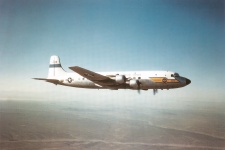 |
This C-118 Liftmaster in natural metal shows off the prominent yellow-orange MATS logo on the nose that was common in the 1950s. The C-118 was used by both the USAF and the USN (as the R6D), in the latter until the 1980s. |
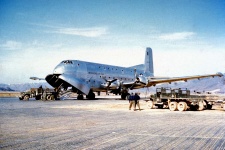 |
With its large clamshell doors that facilitated loading and its ability to carry a tank, the C-124 Globemaster II had capabilities unavailable to any previous strategic transport. This aircraft is seen unloading cargo during the Korean War. |
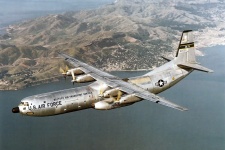 |
The C-133 Globemaster III was the last non-jet strategic transport to be introduced to the MATS. However, it would soon be overshadowed by the need for a dedicated jet transport. |
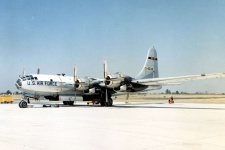 |
The MATS not just tasked with strategic airlift but also encompassed many other duties such as the weather reconnaissance. This WD-50 was assigned to the MATS's Air Weather Service (AWS) and shows the solar reflective white topside. |
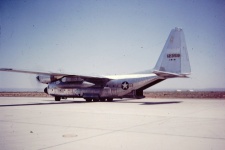 |
Until the introduction of TAC camouflage in 1964, TAC tactical transports like this C-130 had identical natural metal finishes as their MATS counterparts. This one can be seen with the solar reflective white on the upper fuselage. (Source: Benjamin Donnelly) |
Military Airlift Command (1966-1981)
On 8 January 1966, the MATS was superseded by the Military Airlift Command (MAC). Its creation was preceded by a renewed emphasis on expanding the US's global airlift capability as part of President John F. Kennedy's new policy (established in 1961) of Flexible Response. This included the development of the first jet transports which were sorely needed in a service still entirely reliant on propeller-driven designs. MAC transports transports initiallly remained in their natural metal finish since camouflage was not seen as necessary on non-tactical aircraft. However, corrosion became a problem particularly during the heavy workload and harsh tropical climate over Vietnam which required touch ups using silver or gray paint. An elegant new scheme, which resembled that of a civilian airliner, was finally adopted in 1971. This retained the heat reflective 17875 Insignia White upper surfaces seen on earlier aircraft but added FS 16473 Aircraft Gray on all other surfaces including the lower fuselage and both sides of the wings and horizontal stabilizers. Adding to the airliner look was a narrow FS 15044 Insignia Blue cheatline between the two colors. FS 15044 is a very dark blue, easily confused for black at a distance, that has been used as the standard color for national insignia as well as the USAF/ANG lettering on the fuselage and wings. When applicable, radomes were FS 17038 Black. The new scheme was most recognizable on what would be the MAC's two main strategic jet transports, the C-141 and the C-5, which by the 1970s had almost fully replaced the older propeller-driven fleet. Although the scheme did not have an official name, it is frequently referred to as the Grey/White scheme.
In 1974 it was decided to transfer the TAC's tactical transports into the MAC, essentially consolidating the majority of airlift assets into a single command. Tactical transports at the time used the same TAC camouflage scheme as other tactical combat aircraft and retained it even after their incorporation into the MAC. It was only after the adoption of the Euro I scheme in 1981 that all major MAC transports shared the same camouflage scheme. Nevertheless, the Gray/White scheme would remain the standard for strategic-sized aircraft that do not have a specific camouflage scheme specified (much like the ADC scheme became the standard for tactical-sized aircraft). The use of civilian-inspired gray/white schemes on transports or other strategic-sized aircraft was not only limited to the US: similar schemes were adopted contemporaneously by numerous other air forces, notably the Royal Air Force as well as the Soviet/Russian Air Force where it is still in widespread use.
An additional advantage of a civilian-like scheme was that it made it easier for countries that were not particularly friendly towards the US to allow these aircraft in their territory such as during humanitarian relief operations, as they appeared less hostile than a camouflaged aircraft. As a reuslt, even after the adoption fo Euro I, a small number of MAC strategic transports retained the Grey/White scheme should they be required for this purpose.
Paint guide:
- FS 17875 Insignia White: Described previously.
- FS 16473 Aircraft Gray: Described previously.
- FS 15044 Insignia Blue: A rather rare color despite its widespread use for national insignia and markings. The few available options appear suitably dark for the chip color although perhaps a bit of lightening is appropriate to make the narrow cheatline stand out as blue (especially on 1/144 scale which is the most popular for large aircraft).
| FS 17875 | FS 16473 | FS 15044 | |
| Insignia White | Aircraft Gray | Insignia Blue | |
| Schemes | |||
| Gray/White | Upper | Lower / Wings | Cheatline |
| Color matches | |||
| Gunze Mr. Color | C316 | C73 | C326 |
| Gunze Mr. Hobby | H316 | H57 | - |
| Humbrol | - | - | - |
| Italeri | 4696AP (!) | - | - |
| Model Master | 1745 | 1731 | 1719 |
| Revell | - | - | - |
| Tamiya Acrylic | - | - | - |
| Tamiya Lacquer | LP-34 | - | - |
| Vallejo Model Air | 71.279* | 71.335** | 71.091** |
| Vallejo Model Color | - | - | - |
| AKAN | - | 6/72027 | 62006 |
| AK 3Gen Acrylic | AK11868 | AK11867 | - |
| AK Real Colors | RC891 | RC890 | - |
| AMMO by Mig | - | - | - |
| Hataka | HTK-_043 | HTK-_045 | - |
| Lifecolor | UA 148 | UA 041 | LC 35** |
| Mission Models | MMP-104 | MMP-102 | - |
| Mr. Paint | MRP-99 | MRP-242 | MRP-300* |
| Xtracolor | X141 | X138 | - |
| Xtracrylix | XA1141 | XA1138 | - |
MAC Euro I scheme (1981-1992)
The Euro I scheme has been the only one ever adopted by all three of the USAF's main combat commands, and this included the Military Airlift Command (MAC) from 1981 onward. The MAC version of this scheme was closer to the TAC original, retaining FS 34102 Medium Green and FS 34092 Gunship Green but toning down the gray to FS 36118 Medium Gunship Gray. Of the three major commands that adopted the Euro I scheme, the MAC was the only one to not apply it as a wraparound: the two greens were only applied to the upper and side surfaces which left FS 36118 as the only underside color. Given that the two greens extended quite low on the fuselage sides, the monotone underside was not very evident unless the aircraft was seen from below. An oddity of the MAC's Euro I scheme was the alarmingly frequent appearance of a black-green color which was not specified in T.O. 1-1-4 or any official diagrams. It was almost always seen in areas corresponding to FS 34092. It has been suggested that this color may have been a mistaken application of FS 34079 Forest Green (which was used on some TAC Euro I variants) or an even darker green like FS 34052 Marine Green which is it more closely resembles. When combined with a faded FS 36118, the result was a resemblance to the Land Camouflage Scheme used on USMC helicopters.
The Euro I scheme gave strategic MAC transports their first truly military appearance having previously used natural metal finishes or civilian-inspired colors. Although one can question the need for such camouflage on heavy transports like the C-141 and C-5, it was undoubtedly appropriate for tactical transports like the C-130. The MAC was officially inactivated on 1 June 1992 after which all tactical and strategic airlift assets were transferred to the newly created Air Mobility Command (AMC). This led to a transition towards a new gray scheme although Euro I was still seen on many transports (mainly the C-130 and its derivatives) well into the second half of the 1990s.
Somewhat resembling the mysterious black-green Euro I was a secretive scheme known as '3M Blackbird' or '3M Black Velvet' which was used on special operations variants of the C-130 (initially the C-130E Rivet Clamp and later MC-130E Talon) during the Vietnam War. It initially consisted of a light green-gray (or tan-gray) topside and a light gray underside with a disruptive black-gray (or black-green) applied throughout the entire airframe. The underside light gray was eventually replaced with the black-gray around the time of the TAC's switch to wraparound colors in 1979. It is not believed that these colors directly matched any FED-STD color.
Paint guide:
- All colors described previously. The best equivalent to the unspecified dark green is probably FS 34052 or RLM 70.
| FS 34092 | FS 34102 | FS 36118 | |
| Gunship Green | Medium Green | Medium Gunship Gray | |
| Schemes | |||
| MAC Euro I | Upper Camo | Upper Camo | Upper Camo / Lower |
| Color matches | |||
| Gunze Mr. Color | C302 | C303 | C305 |
| Gunze Mr. Hobby | H302 | H303 | H305 |
| Humbrol | 149 | 117 | 125 |
| Italeri | 4729AP | 4862AP | 4752AP |
| Model Master | 1764 | 1713 | 1723 |
| Revell | - | - | 74 |
| Tamiya Acrylic | - | - | (XF-24) |
| Tamiya Lacquer | - | - | - |
| Vallejo Model Air | 71.124* | 71.289 | 71.097* |
| Vallejo Model Color | 70.895 | - | 70.836* |
| AKAN | 6/72041 | 6/72003 | 6/72040 |
| AK 3Gen Acrylic | AK11873 | AK11342 | AK11881 |
| AK Real Colors | RC902 | RC905 | RC913 |
| AMMO by Mig | A.MIG-238 | A.MIG-004 | A.MIG-204 |
| Hataka | HTK-_056 | HTK-_021 | HTK-_031 |
| Lifecolor | UA 008 | UA 002 | UA 022 |
| Mission Models | - | MMP-028** | MMP-084 |
| Mr. Paint | MRP-235* | MRP-102 | MRP-40 |
| Xtracolor | X114 | X116 | X130 |
| Xtracrylix | XA1114 | XA1116 | XA1130 |
SAC Tanker schemes (1948-1985)
The art of aerial refueling was developed experimentally during World War II but its first operational use came on 6 July 1951 when a recon flight of RF-80As was refueled off the coast of North Korea by a KB-29, a variant of the B-29 bomber modified into a tanker. Due to their strategic value, tanker aircraft were assigned to the SAC for the duration of the Cold War and mostly consisted of modified versions of existing transports or airliners. Like transports, SAC tankers were initially fielded in their natural metal finish, with relatively austere markings compared to their MATS/MAC counterparts. The KC-97 Stratofreighter was sometimes seen with ANA 511 Insignia White (later FS 17875) painted on top of the flight deck for solar reflection purposes.
Based on the hugely successful Boeing 707 airliner, the KC-135 Stratotanker was introduced in 1957 and finally gave the SAC its first jet tanker. In line with other natural metal aircraft, it was eventually given an anti-corrosive aluminized epoxy coat known as Coroguard which had been previously used by the US Navy. This resulted in a uniform metallic finish that was noticeably darker and duller than natural metal. A SAC sash and crest was also prominently painted on the fuselage, forward of the wing emergency exit. A section of the aircraft that was not coated with Coroguard were the engine cowlings which were painted FS 17875. From the late 1970s there was a (partial) transition to overall FS 16473 Aircraft Gray, the default color at the time for all aircraft not covered by any other camouflage scheme. However, many aircraft retained the Coroguard scheme well into the 1980s, although engine cowlings were now painted FS 16473 regardless.
The KC-135 was joined in 1981 by the larger KC-10 Extender which was delivered with a variant of the MAC's Gray and White scheme. The main difference was the use of a lighter blue color for the cheatline which went on to cover the forward fuselage area around and above the flight deck. This color has been cited as a proprietary blue used by McDonnell Douglas but has been approximated to FS 15102 True Blue. Another difference were the natural metal leading edges. Some KC-135s have also been seen since the 1970s with a Gray and White scheme although these aircraft did not belong to the SAC, and instead were part of other USAF organizations involved with research and development such as the Aeronautical Systems Center (ASC) and Air Force Materiel Command (AFMC).
Paint guide:
- FS 17875 Insignia White: Described previously.
- FS 16473 Aircraft Gray: Described previously.
- FS 15102 True Blue: True Blue is not well-represented but is so close to a generic medium blue that any such basic color is acceptable. A reasonably close approximation is RAL 5005.
- FS 17038 Black: Described previously.
Sources:
- Reed, C.M. (1991). KC-135 Stratotanker in action. Aircraft Number 118. Squadron/Signal Publications. Carrollton, Texas.
| FS 17178 | FS 17875 | FS 16473 | FS 15102 | |
| Aluminum | Insignia White | Aircraft Gray | True Blue | |
| Schemes | ||||
| Early | Overall | |||
| Mid (KC-135) | Overall | |||
| Late (KC-10) | Upper | Lower | Cheatline / Nose | |
| Late (KC-135) | Overall | |||
| Color matches | ||||
| Gunze Mr. Color | C8 | C316 | C73 | - |
| Gunze Mr. Hobby | H8 | H316 | H57 | - |
| Humbrol | 56 | - | - | - |
| Italeri | 4678AP | 4696AP (!) | - | - |
| Model Master | 1781 | 1745 | 1731 | 2030 |
| Revell | 99 | - | - | - |
| Tamiya Acrylic | XF-16 | - | - | - |
| Tamiya Lacquer | LP-11 | LP-34 | - | - |
| Vallejo Model Air | 71.062 | 71.279* | 71.335** | - |
| Vallejo Model Color | - | - | - | - |
| AKAN | 6/76004 | - | 6/72027 | - |
| AK 3Gen Acrylic | AK11287 | AK11868 | AK11867 | - |
| AK Real Colors | RC8200 | RC891 | RC890 | - |
| AMMO by Mig | A.MIG-194 | - | - | A.MIG-229 |
| Hataka | HTK-_078 | HTK-_043 | HTK-_045 | HTK-_220* |
| Lifecolor | LC 74 | UA 148 | UA 041 | - |
| Mission Models | MMM-003 | MMP-104 | MMP-102 | - |
| Mr. Paint | MRP-3 | MRP-99 | MRP-242 | MRP-384* |
| Xtracolor | X142 | X141 | X138 | - |
| Xtracrylix | XA1216 | XA1141 | XA1138 | - |
Shamu scheme (1985-1992)
In the mid-1980s, the SAC's tanker fleet began adopting a very high contrast camouflage that unofficially became known as the Shamu scheme, named after a popular SeaWorld orca at the time. Like many contemporary schemes, it was optimized for low-altitude operations although the justification for such a dark scheme is questionable given that aerial refueling is usually done at higher altitude. The Shamu scheme consisted of a dark topside color of FS 36081 Dark Gunship Gray with a much lighter underside color of FS 16473 Aircraft Gray. The wave pattern demarcation on the lower fuselage sides further contributed to the similarity with an orca. It is known that McDonnell Douglas used a proprietary gray for the underside color of KC-10s, known as Douglas DN3536 Gray. This was slightly lighter than FS 16473 and without the bluish tint, and is said to approximate FS 16515 Boeing Gray. Being the smaller of the two tankers, the version of this scheme used on the KC-135 was often known as Baby Shamu.
The Shamu scheme was short lived, being first seen around 1988 until the mid-1990s and was never universally adopted as many tankers were still seen in the older schemes during this period. Its peak usage was around the time of the Gulf War when the majority of tankers during that conflict flew in Shamu colors. Unfortunately, the desert environment made Shamu tankers stand out considerably more, which was likely one of the incentives to abandon the scheme altogether in the years that followed.
Paint guide:
- FS 36081 Dark Gunship Gray: Described previously.
- FS 16473 Aircraft Gray: Described previously.
- DN3536 Douglas Gray: Described as FS 16515 Boeing Gray in the Airborne Early Warning schemes section.
Links:
| FS 36081 | FS 16473 | (FS 16515) | |
| Dark Gunship Gray | Aircraft Gray | Douglas Gray | |
| Scheme | |||
| Shamu (KC-135) | Upper / Sides | Lower | |
| Shamu (KC-10) | Upper / Sides | Lower | |
| Color matches | |||
| Gunze Mr. Color | C301 | C73 | - |
| Gunze Mr. Hobby | H301 | H57 | - |
| Humbrol | 032 | - | - |
| Italeri | 4861AP (!) | - | - |
| Model Master | 1788 | 1731 | 2039 |
| Revell | - | - | - |
| Tamiya Acrylic | - | - | - |
| Tamiya Lacquer | - | - | - |
| Vallejo Model Air | 71.314* | 71.335** | - |
| Vallejo Model Color | - | - | - |
| AKAN | 6/72008 | 6/72027 | - |
| AK 3Gen Acrylic | - | AK11867 | - |
| AK Real Colors | RC912 | RC890 | - |
| AMMO by Mig | - | - | - |
| Hataka | HTK-_030 | HTK-_045 | - |
| Lifecolor | UA 030 | UA 041 | UA 043 |
| Mission Models | - | MMP-102 | - |
| Mr. Paint | MRP-241 | MRP-242 | MRP-363 |
| Xtracolor | X129 | X138 | X150 |
| Xtracrylix | XA1129 | XA1138 | - |
Air Combat Command /Air Mobility Command schemes (1992-Current)
The end of the Cold War resulted in a major reorganization of the USAF's major commands, which were consolidated into the Air Combat Command (ACC) and the Air Mobility Command (AMC) both of which were activated on 1 June 1992. The ACC received the TAC's tactical aircraft as well as the SAC's strategic bomber force (B-52, B-1, B-2, and FB-111) while the AMC received the MAC's transports (C-130, C-141, C-5) as well as the SAC's tanker fleet (KC-135, KC-10). New color schemes were also introduced which followed the general shift towards grays. The ACC adopted an overall FS 36118 Medium Gunship Gray scheme on all its non-stealth bombers as well as on the F-15E (which used this color since its introduction in 1988) and F-111 attack aircraft. The latter also included FB-111s converted to tactical use from 1989 onward and redesignated F-111G. Meanwhile, the AMC adopted an overall FS 36173 AMC Gray scheme. This color had no previous use on any other major USAF camouflage scheme but is often taken as the direct successor to the wartime Neutral Gray No. 43, with the main difference being that the newer color is slightly bluer and therefore not a true neutral gray. The colors of ACC strategic bombers and tactical attack aircraft as well as AMC transports and tankers have remained unchanged to this day.
Shortly before its inactivation, it was reported that the SAC planned to repaint its tanker fleet in FS 36320 Dark Ghost Gray. In the event, this plan was not carried out although this color was applied experimentally to one KC-10 airframe (83-0082). It too was later repainted in FS 36173.
Paint guide:
- FS 36173: Relatively well represented although matches with Neutral Gray No. 43 should be suspect given that the FED-STD shade is noticeably bluer (this applies to Tamiya XF-53 which is better suited for the wartime shade). Mr. Paint MRP-365 looks perfect in the bottle and Vallejo Model Air 71.051 has the necessary tinge of blue as well. Hataka has separate NG 43 and FS 36173 paints which suggests the latter (HTK-_265) is a closer match to the FED-STD shade.
| FS 36118 | FS 36173 | |
| Medium Gunship Gray | AMC Gray | |
| Scheme | ||
| ACC | Overall | |
| AMC | Overall | |
| Color matches | ||
| Gunze Mr. Color | C305 |
- |
| Gunze Mr. Hobby | H305 | - |
| Humbrol | 125 | - |
| Italeri | 4752AP | 4754AP |
| Model Master | 1723 | 2035 |
| Revell | 74 | - |
| Tamiya Acrylic | (XF-24) | - |
| Tamiya Lacquer | - | - |
| Vallejo Model Air | 71.097* | 71.051 |
| Vallejo Model Color | 70.836* | 70.992 |
| AKAN | 6/72040 | 6/72072 |
| AK 3Gen Acrylic | AK11881 | - |
| AK Real Colors | RC913 | - |
| AMMO by Mig | A.MIG-204 | - |
| Hataka | HTK-_031 | HTK-_265 |
| Lifecolor | UA 022 | UA 046* |
| Mission Models | MMP-084 | - |
| Mr. Paint | MRP-40 | MRP-365 |
| Xtracolor | X130 | X158 |
| Xtracrylix | XA1130 | XA1158 |
![]()
OTHER
Cockpits and Interiors (1947-Current)
USAF aircraft in the early post-war period were most commonly painted in two sheens of black. Instrument panels received the aptly named, semi-gloss ANA 514 Instrument Black (later FS 27038) whereas all other sections of the cockpit received the flat ANA 604 Black (later FS 37038) to help reduce reflections. However, it was not uncommon for some sections to be painted in the myriad of interior greens that were used during World War II and which varied between aircraft and manufacturer (see the USAAF page for more information). In November 1953, the order was given to factory paint cockpits on all newly-built US aircraft of all branches in ANA 621 Dark Gull Gray (later FS 36231). Further details were specified under MIL-C-8779(ASG) dated 7 July 1955 which also called for instrument bezels, mounting flanges, and adjustment knobs to be painted ANA 604 (FS 37038), resulting in a fully non-spectacular (flat) cockpit. This standard has remained in place to this day and has even been adopted on many NATO multi-national aircraft such as the Tornado and Eurofighter given that many of the partner countries use FED-STD colors as well.
In the immediate post-war years, interior areas like wheel wells, wheel covers, and landing gear remained in their wartime colors, which like cockpits varied between aircraft and manufacturer. Natural metal (later specified as FS 17178 Aluminum) on landing gears predominated and it was customary to paint wheel wells and sometimes wheel covers in any variety of zinc chromate primers or interior greens (see the USAAF page for more information). Around the 1960s, interior colors including the landing gear were partially standardized at FS 17875 Insignia White with the exception of wheel wells which were to be painted FS 16473 Aircraft Gray. Notably, T.O. 1-1-4 specified both the former and standard colors for aircraft which were introduced before the change. Aircraft that were introduced from the late 1970s onwards (including all fourth-generation fighters) had their interior colors specified by their individual technical orders rather than T.O. 1-1-4. In most cases, these featured FS 17875 on all interiors including the wheel wells. A few exceptions to the above rules include the C-5 which has FS 17925 Untinted White wheel wells, and the C-130 which retains its original FS 17178 wheel wells. Additionally, the F-15 uses a metallic blue-green (turquoise) primer for many of its avionics compartments. Initially, this also included the large avionics bay behind the cockpit (on single-seaters) although this was changed to FS 17875 on aircraft ordered from fiscal year 1979 onward, with earlier aircraft eventually having them repainted after undergoing maintenance. This color is a proprietary shade developed for McDonnell Douglas and is not matched to any FED-STD color.
Paint guide: All of these colors are widely available.
- Metallic Blue-Green Primer: This is a difficult match and not well represented, Xtracolor (X159) being the only range which offers it. However, it is similar to the turquoise color of Soviet cockpits albeit with a subtle metallic sheen due to it containing aluminum. Gunze makes a Metallic Blue Green (H63/C57) but it matches a World War II IJA/IJN color and is too blue, although this could be mixed in a 2:1 ratio with Metallic Green (C77/H89) to approximate the shade. A 1:1 mix between Metallic Blue (C76/H88) and Metallic Green (C77/H89) could also work.
| ANA 621 | ANA 604 | ANA 511 | ANA 512 | |
| FS 36231 | FS 37038 | FS 17875 | FS 16473 | |
| Dark Gull Gray | Black | Insignia White | Aircraft Gray | |
| Scheme | ||||
| Standard | Cockpit | Instruments | Interiors | (Wheel Wells) |
| Color matches | ||||
| Gunze Mr. Color | C317 | C33 | C316 | C73 |
| Gunze Mr. Hobby | H317 | H12 | H316 | H57 |
| Humbrol | 140 | 33 | - | - |
| Italeri | 4755AP | 4768AP | 4696AP (!) | - |
| Model Master | 1740 | 1749 | 1745 | 1731 |
| Revell | - | 08 | - | - |
| Tamiya Acrylic | (XF-54) | XF-1 | - | - |
| Tamiya Lacquer | - | LP-3 | LP-34 | - |
| Vallejo Model Air | 71.277* | 71.057 | 71.279* | 71.335** |
| Vallejo Model Color | 70.991 | 70.950 | - | - |
| AKAN | 62009 | 78003 | - | 6/72027 |
| AK 3Gen Acrylic | AK11884 | AK11029 | AK11868 | AK11867 |
| AK Real Colors | RC916 | RC804 | RC891 | RC890 |
| AMMO by Mig | A.MIG-205** | A.MIG-046 | - | - |
| Hataka | HTK-_044* | HTK-_041 | HTK-_043 | HTK-_045 |
| Lifecolor | UA 033 | LC 02 | UA 148 | UA 041 |
| Mission Models | MMP-064 | MMP-047 | MMP-104 | MMP-102 |
| Mr. Paint | MRP-100 | MRP-5 | MRP-99 | MRP-242 |
| Xtracolor | X131 | X404 | X141 | X138 |
| Xtracrylix | XA1131 | - | XA1141 | XA1138 |
Bombs and Missiles (1947-Current)
To this day, bombs have been painted in the prevalent shade of Olive Drab in use by the USAF, this being FS 34087 since the implementation of FED-STD-595 and currently FS 34088 since FED-STD-595B. Missiles were originally painted FS 17875 Insignia White with some exceptions being missiles with short-range tactical use such as the AGM-65 Maverick which was frequently painted FS 34087 as well, possibly since many were intended to be carried by camouflaged tactical aircraft (Euro I scheme A-10s for example). In the late 1980s (exact date and specification unknown to this author), missiles began to be painted in FS 36375 Light Ghost Gray, this also likely due to the prevalence of ghost gray schemes by both the USAF and USN/USMC. Certain missile parts such as radomes were also seen in an unknown light gray or FS 17875 (unlike the USN/USMC, the USAF did not typically use FS 33613 Radome Tan on missile radomes) or left unpainted such as the metallic head on the AIM-9 Sidewinder. Given that missiles tend to be replaced much quicker than airframes, the switch to FS 36375 is more closely associated with certain missile variants such as the AIM-7M and AIM-9L which were the ones in service when the change occurred. A notable exception is the AGM-88 HARM missile which to this day remains painted in FS 17875. Aside from its use on missiles, FS 36375 is also the color of the strake and tail units of JDAM bombs, and since the 2000s, the guidance and tail units of Paveway-series laser-guided bombs. Previously, Paveways were painted entirely in Olive Drab.
US munitions have different sections denoted by color coded warning stripes, which helps identify the presence of explosives, propellants, or any other element of the munition of relevance to ground crews. These are specified in MIL-STD-709 (most recent version is MIL-STD-709D w/CHANGE 1 from 3 May 2011) and applies to all US military branches. The most common of these include FS 33538 International Yellow for high explosive (usually placed at the front of a bomb or missile warhead), FS 30117 International Brown or FS 30140 Special Brown for low explosives (this includes the rocket or engine of a missile), and FS 35109 International Blue for practice ammunition (practice bombs are fully colored in FS 35109). Contrary to popular belief, blue-painted practice ammunition is not by definition inert and may contain high or low explosives. Less common today but still used widely in wars such as Vietnam is FS 31158 International Red for incendiary material including napalm. More recently, these color codes have been standardized across NATO (all colors are standardized internationally as well) and can be seen on all ammunition whether of US or non-US origin. Ammunition colors remain specified at a national level, however, although colors equivalent or similar to FS 34088 for bombs and FS 36375 for missiles predominate.
Arctic / Conspicuity schemes (1946-Current)
Although the purpose of camouflage is to conceal, in some cases, the opposite effect is needed. During World War II there was a need to apply high visibility markings to aircraft operating in arctic regions (or polar regions in general) in order to facilitate the identification of wrecks over snowy terrain. This was done in a somewhat ad hoc manner using ANA 509 Insignia Red (later FS 11136), a scarlet red that is widely used on markings, national insignia, and virtually any other use of red needed on US aircraft. In 1946, the first proper arctic markings were standardized and involved painting ANA 509 on the rear fuselage and fins as well as on the tips of the wings. The exact length of the wingtip sections was to vary over the next decade but could be as much as half of the total wing span. The original arctic markings did not include the aircraft's nose. Additionally, movable surfaces and leading edges were left free from these markings, something that remains standard practice to this day.
In 1958 the USAF introduced a similar system of so-called conspicuity markings, intended to make aircraft highly visible for operations such as testing and training. It was also decided to use fluorescent paint which was more effective than regular paint, although with the drawback of being significantly more expensive and prone to very quick fading. In response, conspicuity markings were limited to four- or six-foot bands (depending on the size of the aircraft) on the nose, the rear fuselage in front of the stabilizers, and the wingtips. The color chosen for this was ANA 634 Fluoresecent Yellow-Orange (later FS 28915) which unlike its name would suggest, was closer to a pure orange with no trade of yellow. This color was replaced in 1960 (though not before existing paint stocks were finished) with ANA 633 Fluorescent Red-Orange (later FS 28913), which was visibly redder than its predecessor although it would look almost identical after fading. Note that neither is an equivalent to RAL 2005, which was used for similar purposes on German aircraft, which is closer to FS 38093 and sits roughly in between ANA 633/634 in terms of hue. Both of these colors were added to the ANA palette specifically for conspicuity purposes and were referenced in T.O. 1-1-4 well after the switch to FED-STD. Shortly thereafter, arctic markings switched to the same fluorescent paints and were also limited to six-foot bands on the wing tips and the rear fuselage starting at the leading edge of the stabilizers, including the tail. Nose markings were added in 1967 although many recent aircraft now appear without them.
The high cost of fluorescent paint resulted in a switch to FS 12197 International Orange in 1970, and has remained the standard conspicuity color up to this day. This was another very red orange but lacking the fluorescence of its predecessor. It is worth mentioning that arctic and conspicuity markings are not a scheme in themselves but are applied on top of any other scheme specified for that command. Among the most common were the ADC scheme due to the large number of fighter-interceptor squadrons operating in the northern USA, Alaska, and Canada (as part of NORAD), as well as the MATS and MAC schemes for transports and special purpose aircraft which operated in the arctic.
Paint guide:
- FS 11136 Insignia Red: Relatively well available given its extensive use as the default red on US military aircraft, though still missing from some major brands (Tamiya, Vallejo Model Air, and AK Real Colors). Note that Vallejo Model Color 70.957 is matched to ANA 619 which is the correct flat version of this color.
- FS 28915 Fluorescent Yellow-Orange: Only Model Master used to carry this color. Being closer to a pure orange (though still with some reddishness), some of the generic luminous colors from Gunze or AK might be close enough, perhaps mixing with a bit of red. These are included in parenthesis.
- FS 28913 Fluorescent Red-Orange: Almost as poorly matched as its predecessor. Being closer to a pure red (though still with some orange in it), some of the generic luminous colors from Gunze or AK might be close enough, perhaps mixing with a bit of orange. These are included in parenthesis. This color is close to RAL 3024 so matches to that are in parenthesis, with the exception being Revell which is matched to RAL 3026 which is also quite close.
- FS 12197 International Orange: Poorly available which is a shame given that it's the current US hi-vis color and still used extensively. Mr. Paint MRP-232 matches BS381C 592 which is virtually identical.
Sources:
- Bell, Dana (1996). 'High-Vis!', FineScale Modeler, 14(3), pp. 46-49
| ANA 509 | ANA 634 | ANA 633 | ANA 508 | |
| FS 11136 | FS 28915 | FS 28913 | FS 12197 | |
| Insignia Red | Flourescent Yellow-Orange | Flourescent Red-Orange | International Orange | |
| Scheme | ||||
| Arctic (1946) | Overall | |||
| Conspicuity (1958) | Overall (1) | Overall (2) | ||
| Conspicuity (1970) | Overall | |||
| Color matches | ||||
| Gunze Mr. Color | C327 | (C173) | (C171) | - |
| Gunze Mr. Hobby | H327 | (H98) | (H101) | - |
| Humbrol | 153 | - | (209) | - |
| Italeri | 4714AP | - | - | 4682AP |
| Model Master | 1705 | 1775 | 2041 | 2022 |
| Revell | - | - | (332) | - |
| Tamiya Acrylic | - | - | - | - |
| Tamiya Lacquer | - | - | - | - |
| Vallejo Model Air | - | - | - | - |
| Vallejo Model Color | 70.957* | - | - | - |
| AKAN | 6/72000 | - | - | - |
| AK 3Gen Acrylic | (AK11092) | (AK11081) | - | - |
| AK Real Colors | - | (RC838) | (RC837) | - |
| AMMO by Mig | - | - | - | - |
| Hataka | HTK-_219* | - | (HTK-_268) | HTK-_062 |
| Lifecolor | - | - | - | - |
| Mission Models | MMP-101 | - | - | - |
| Mr. Paint | MRP-299* | - | (MRP-193) | MRP-232** |
| Xtracolor | X103 | - | X161 | X104 |
| Xtracrylix | XA1103 | - | - | - |
Stealth schemes (1965-Current)
Lockheed's Advanced Development Programs (ADP), better known as Skunk Works, is the company's secretive R&D unit in charge of developing highly classified advanced aircraft designs. It has been a pioneer in developing high-altitude reconnaissance platforms like the U-2 and SR-71 spy planes as well as stealth aircraft like the F-117. Skunk Works designs were among the first to put in practice radar absorbent coatings, the first of which was known as Black Velvet. This paint, initially applied to U-2 spy planes in 1965, was composed of small glass beads and metal particles which helped reduce light reflections and also had some moderate effect on reducing radar reflections. Black Velvet was followed up by Iron Ball paint which further developed its radar reflectivity properties by using carbonyl iron or ferrite particles suspended in an epoxy paint that deflected and dissipated radar waves, converting them into heat. It was applied to spy planes like the U-2, A-12, and SR-71. The F-117, introduced in the 1980s, was the first true stealth aircraft and featured a further development of Iron Ball which, although still classified, is believed to consist of carbon black or ferrite particles on a neoprene foil glued to the aircraft using a special adhesive. Visually speaking, it appears virtually identical to Blue Velvet and Iron Ball all of which most closely resemble FS 37038 Black. .
Another aircraft to use Iron Ball coatings is Northrop's B-2 bomber. Its coating is notable for having a slightly satin sheen to it in contrast to the very matt predecessors as well as being noticeably lighter. It is almost certainly intended to match FS 36118 Medium Gunship Gray which by the time of the B-2's introduction in 1997 had become the standard color of the USAF's strategic bomber fleet. However, most photos that show the B-2 next to other bombers show it to have a slightly different shade gray, possibly closest in practice to FS 36099 Dark Blue Gray. Since the 2000s, B-2 have used a new coating developed by Northrop known as Alternate High Frequency Material (AHFM) but appears visually similar to its predecessor. It is unclear (to this author) whether this is a further development of Iron Ball or uses a separate radar absorption technology.
Paint guide:
- Iron Ball (Lockheed):A basic flat black will do. Although it is often recommended to paint black aircraft with a slightly lighter color like FS 37030, the F-117 invariably looked black as night due to the necessary upkeep needed to keep its stealth coating effective.
- Iron Ball (Northrop): This is probably intended to approximate FS 36118 although FS 36099 (unfortunately quite rare) could be used as an alternative to add some variety of shades.
Sources:
- Radar Absorbing Materials - Key To Stealth (Jawaaz Ahmad @ electronicsforu.com)
- Black or Blue? The true colors of the U-2 (Chris Pocock)
| (FS 37038) | (FS 36118) | |
| Iron Ball (L) | Iron Ball (N) | |
| Scheme | ||
| Stealth (Lockheed) | Overall | |
| Stealth (Northrop) | Overall | |
| Color matches | ||
| Gunze Mr. Color | C33 | C305 |
| Gunze Mr. Hobby | H12 | H305 |
| Humbrol | 33 | 125 |
| Italeri | 4768AP | 4752AP |
| Model Master | 1749 | 1723 |
| Revell | 08 | 74 |
| Tamiya Acrylic | XF-1 | (XF-24) |
| Tamiya Lacquer | LP-3 | - |
| Vallejo Model Air | 71.057 | 71.097* |
| Vallejo Model Color | 70.950 | 70.836* |
| AKAN | 78003 | 6/72040 |
| AK 3Gen Acrylic | AK11029 | AK11881 |
| AK Real Colors | RC804 | RC913 |
| AMMO by Mig | A.MIG-046 | A.MIG-204 |
| Hataka | HTK-_041 | HTK-_031 |
| Lifecolor | LC 02 | UA 022 |
| Mission Models | MMP-047 | MMP-084 |
| Mr. Paint | MRP-5 | MRP-40 |
| Xtracolor | X404 | X130 |
| Xtracrylix | - | XA1130 |
Aggressor schemes (1965-Current)
The US Navy pioneered dissimilar air combat training (DACT) in 1969 in its now legendary Fighter Weapons School ("Top Gun") school in 1969 to better prepare its pilots against real world adversaries and tactics. The USAF followed suit in 1972 and this has been a feature of air combat training since, with both services maintaining a number of aggressor squadrons trained in adversary tactics and whose aircraft are painted in camouflage similar to that was used by the USSR, the Warsaw Pact, as well as hostile Asian and Middle Eastern air forces. Many of these feature FED-STD colors that are otherwise not seen on other standard camouflage schemes. The number of Aggressor schemes is huge, with around two dozen used since the program began and each squadron typically carries a mix of them at any given time. The USAF currently operates three aggressor squadrons, these being the 64th and 65th AS based at Nellis AFB, Nevada and the 18th AS based at Eilson AFB, Alaska. Former squadrons included the 527th AS based at RAF Alconbury (later RAF Bentwaters) in the UK and the 26th AS based at Clark AB in the Philippines.
Aggressor schemes carry anything from two to four colors, either as wraparound or with a separate underside color. Although the majority of these colors had a specific FED-STD-595 match, in some cases these used a mix which is provided as a ratio in the tables below. The following schemes are the most well known, some of which were named after their intended adversary such as the Flogger scheme (Soviet/Warsaw Pact tactically camouflaged MiG-23/27s) and Fulcrum scheme (the MiG-29). Notably, the VNAF scheme used the same colors as the contemporary TAC camouflage scheme due to it being aircraft that had been brought back to the US after Vietnam service.
The following schemes were primarily used on the initial T-38 and F-5 aggressors. Those that do not have a lower camouflage color specified are wraparound.
| Upper | Upper | Upper | Lower | |
| VNAF | ||||
| FS 30219 | FS 34102 | FS 34079 | FS 36622 | |
| Old Blue | ||||
| FS 35414 | FS 35190 | FS 35164 | FS 35622 | |
| New Blue | ||||
| FS 35414 | FS 35164 | FS 35109 | ||
| Sand | ||||
| FS 33690 | FS 33613:4 FS 30227:1.5 |
FS 30227:4 FS 33690:1.5 |
||
| Frog | ||||
| FS 33717 | FS 30111 | FS 34052 | FS 35622 | |
| Pumpkin | ||||
| FS 33695 | FS 34098 | FS 33690 | ||
| Grape | ||||
| FS 35414 | FS 35109 | FS 35164 | FS 35622 | |
| Snake | ||||
| FS 33531 | FS 34258 | FS 30118 | FS 33531 | |
| Old Ghost | ||||
| FS 35237 | FS 36307 | FS 36251 | FS 35622 | |
| New Ghost (1) | ||||
| FS 36622:4 FS 37038:1 |
FS 36492:8 FS 37038:1 |
|||
| New Ghost (2) | ||||
| FS 36622:4 FS 37038:1 |
FS 36270:4 FS 37038:1 |
|||
| Old Lizard | ||||
| FS 33531 | FS 30118 | FS 30118 | ||
| New Lizard | ||||
| FS 33613:8 FS 30117:1.25 |
FS 30117:8 FS 33613:1 |
|||
| Flogger | ||||
| FS 20400 | FS 30140 | FS 34079 |
The following schemes are primarily used on F-16 aggressors, the first of which was delivered to an aggressor squadron in 1989. A smaller number of F-15s have also been used briefly by the 65th AS. These are almost all wraparound schemes that do not have separate understides, the exceptions being the Shark scheme which is intented to replicate the 'Eggplant' scheme used on Russian Su-30s and Su-35s, as well as the Ghost scheme which is intended to repliate the digital camouflage on Russian Su-57s. Certain sections of the aircraft in these schemes such as radomes, pylons, and fuel tanks are often (but not always) left in their default colors of FS 36270 or FS 36375.
| Upper | Upper | Upper | Lower | Lower | |
| Fulcrum | |||||
| FS 36495 | FS 35164 | FS 36495 | |||
| Flogger | |||||
| FS 20400 | FS 30140 | FS 34092 | |||
| Banana | |||||
| FS 33711 | FS 30279 | FS 30140 | |||
| Sand | |||||
| FS 20400 | FS 30279 | FS 30140 | |||
| Blizzard | |||||
| FS 36628 | FS 36251 | FS 35109 | |||
| Arctic Flanker | |||||
| FS 36628 | FS 36251 | FS 37038 | |||
| Blue Flanker | |||||
| FS 35450 | FS 35109 | FS 36251 | |||
| Blue Flanker (2) | |||||
| FS 35450 | FS 35109 | ||||
| Lizard Flanker | |||||
| FS 30279 | FS 30140 | FS 34079 | |||
| Desert Flanker | |||||
| FS 30279 | FS 30140 | ||||
| Splinter | |||||
| FS 36628 | FS 36251 | FS 35109 | |||
| Blue Splinter | |||||
| FS 35450 | FS 35109 | FS 36251 | |||
| Arctic Splinter | |||||
| FS 36628 | FS 36251 | FS 37038 | |||
| BDU Splinter | |||||
| FS 34258 | FS 30140 | FS 37038 | |||
| Wraith | |||||
| FS 37038 | |||||
| Shark | |||||
| FS 36118 | FS 35450 | ||||
| Ghost | |||||
| FS 35450 | FS 35109 | FS 36628 | FS 35109 |
The following equivalences table only includes the colors not included in previous tables and which are used in more than one scheme. Only Hataka and Mr. Paint currently include all the major aggressor colors, although a number of other brands include most. FS 36628 is poorly represented which is a shame, since it is widely used on F-16 aggressors (and is likely the light gray seen on the F-35), but can be approximated with RAL 7035 or FS 36495.
Sources:
- Kinzey, Bert and Leader, Ray (1988). Colors & markings of USAF Aggressor Squadrons, Colors & Markings Vol. 11. Airlife Publishing. Shrewsbury, UK.
| 30279 | FS 33531 | FS 34258 | FS 35622 | FS 35414 | FS 35109 | FS 35164 | FS 36628 | |
| Desert Sand | Sand | Green | Light Blue | Blue Green | Blue | Intermediate Blue | Light Aircraft Gray | |
| Scheme | ||||||||
| All | ||||||||
| Color matches | ||||||||
| Gunze Mr. Color | - | C313 | - | C314 | - | - | C366 | - |
| Gunze Mr. Hobby | - | H313 | - | - | - | - | - | - |
| Humbrol | - | 121 | - | - | - | - | 144 | - |
| Italeri | - | - | - | - | - | - | 4639AP | - |
| Model Master | 2053* | 1706 | 2029 | 1722 | 2033 | 2031 | 1720 | - |
| Revell | - | - | - | - | - | - | - | - |
| Tamiya Acrylic | - | - | - | - | - | - | - | - |
| Tamiya Lacquer | - | - | - | - | - | - | - | - |
| Vallejo Model Air | 71.140* | 71.327 | - | 71.328 | 71.008 | 71.111 | 71.299 | - |
| Vallejo Model Color | - | - | - | - | - | - | 70.900** | - |
| AKAN | 62025 | 6/72026 | - | 72074 | 72061 | 72077 | 6/72050 | - |
| AK 3Gen Acrylic | AK11340 | AK11869 | AK11876 | AK11880 | - | AK11877 | (AK11341) (!) | - |
| AK Real Colors | RC897 | RC898 | - | RC911 | - | - | RC908 | - |
| AMMO by Mig | - | A.MIG-200 | - | - | - | - | A.MIG-228 | - |
| Hataka | HTK-_068* | HTK-_090 | HTK-_093 | HTK-_092 | HTK-_150 | HTK-_156 | HTK-_027* | HTK_154 |
| Lifecolor | UA 089 | - | UA 115** | UA 139** | UA 124** | - | UA 045 | - |
| Mission Models | - | - | - | - | - | - | MMP-071 | - |
| Mr. Paint | MRP-243 | MRP-226 | MRP-248 | MRP-225 | MRP-393 | MRP-238 | MRP-136* | MRP-246 |
| Xtracolor | - | X105 | X120 | X149 | X127 | X124 | X125 | - |
| Xtracrylix | - | - | - | - | - | - | XA1125 | - |
Color Summary Tables
| ANA | TT-C-595 | ||||
| FS 30140 | Brown Special | Camo (Asia Minor, Aggressor) | - | - | |
| FS 30219 | Dark Tan | Camo (TAC) | ANA 628 | - | |
| FS 30279 | Desert Sand | Camo (Aggressor) | ANA 616 | FS 3025 | |
| FS 20400 | Tan Special | Camo (Asia Minor, Aggressor) | - | - | |
| FS 11136 | Insignia Red | Markings, Conspicuity | ANA 509 | - | |
| FS 12197 | International Orange | Conspicuity | ANA 508 | - | |
| FS 33531 | Sand | Camo (Aggressor) | - | - | |
| FS 33613 | Radome Tan | Radomes | - | - | |
| FS 34079 | Forest Green | Camo (TAC, Euro I, SIOP) | ANA 631 | - | |
| FS 34086 | Green Drab | Camo (Euro I) | - | - | |
| FS 34092 | Gunship Green | Camo (Euro I) | ANA 612 | FS 3406 | |
| FS 34102 | Medium Green | Camo (Euro, SEA) | - | - | |
| FS 34151 | Interior Green | Interiors (pre-1953) | ANA 611 | FS 3430 | |
| FS 34159 | SAC Bomber Green | Camo (SIOP) | - | - | |
| FS 34201 | SAC Bomber Tan | Camo (SIOP) | - | - | |
| FS 34258 | Green | Camo (Aggressor) | - | - | |
| FS 15044 | Insignia Blue | Markings, Camo (MAC) | - | - | |
| FS 35109 | Aggressor Blue | Camo (Aggressor) | - | - | |
| FS 35164 | Intermediate Blue | Camo (Aggressor) | ANA 608 | - | |
| FS 35190 | Blue | Camo (Aggressor) | - | - | |
| FS 35414 | Blue Green | Camo (Aggressor) | - | - | |
| FS 35450 | Air Superiority Blue | Camo (F-15A, Aggressor) | - | - | |
| FS 35622 | Light Blue | Camo (Aggressor) | - | - | |
| FS 36081 | Dark Gunship Gray | Camo (Euro I) | - | - | |
| FS 36118 | Medium Gunship Gray | Camo (F-16, Euro I, Hill, ACC) | ANA 603 | FS 3610 | |
| FS 36170 | Camouflage Gray | Camo (F-35, Have Glass) | - | - | |
| FS 36173 | AMC Gray | Camo (AMC) | ANA 601 | FS 3715 | |
| FS 36176 | Mod Eagle Gray | Camo (Mod Eagle) | - | - | |
| FS 36231 | Dark Gull Gray | Cockpits (post-1953) | ANA 621 | FS 3615 | |
| FS 36251 | Aggressor Gray | Camo (Mod Eagle) | - | - | |
| FS 36270 | Medium Gray | Camo (F-16, Hill, Have Glass) | - | - | |
| FS 36320 | Dark Ghost Gray | Camo (Compass) | - | - | |
| FS 36375 | Light Ghost Gray | Camo (Compass, F-16) | - | - | |
| FS 16473 | Aircraft Gray | Camo (ADC, MAC) | ANA 512 | FS 1645 | |
| FS 16515 | Boeing Gray | Camo (AWACS) | - | - | |
| FS 36622 | Camouflage Gray | Camo (SEA) | - | - | |
| FS 36628 | Light Arctic Gray | Camo (Aggressor) | - | - | |
| FS 17038 | Black | Camo | ANA 622 | FS 2710 | |
| FS 27038 | Black | Instruments (pre-1953) | ANA 514 | FS 3725 | |
| FS 37038 | Black | Anti-glare, Stealth | ANA 604 | - | |
| FS 17178 | Aluminum | Natural metal | - | - | |
| FS 17875 | Insignia White | Camo, Interiors | ANA 511 | FS 1755 | |
| FS 17925 | Untinted White | Interiors | - | - | |
| FS 28913 | Flo. Red-Orange | Conspicuity | ANA 633 | - | |
| FS 28915 | Flo. Yellow-Orange | Conspicuity | ANA 634 | - | |
